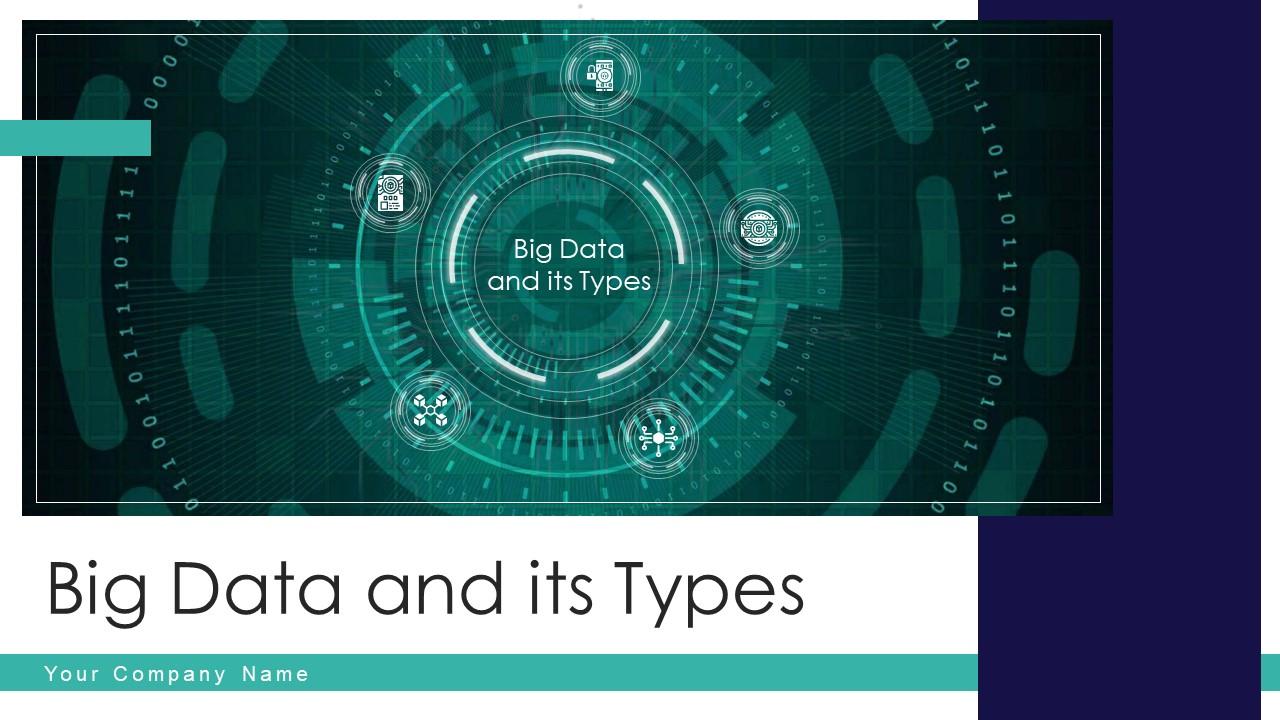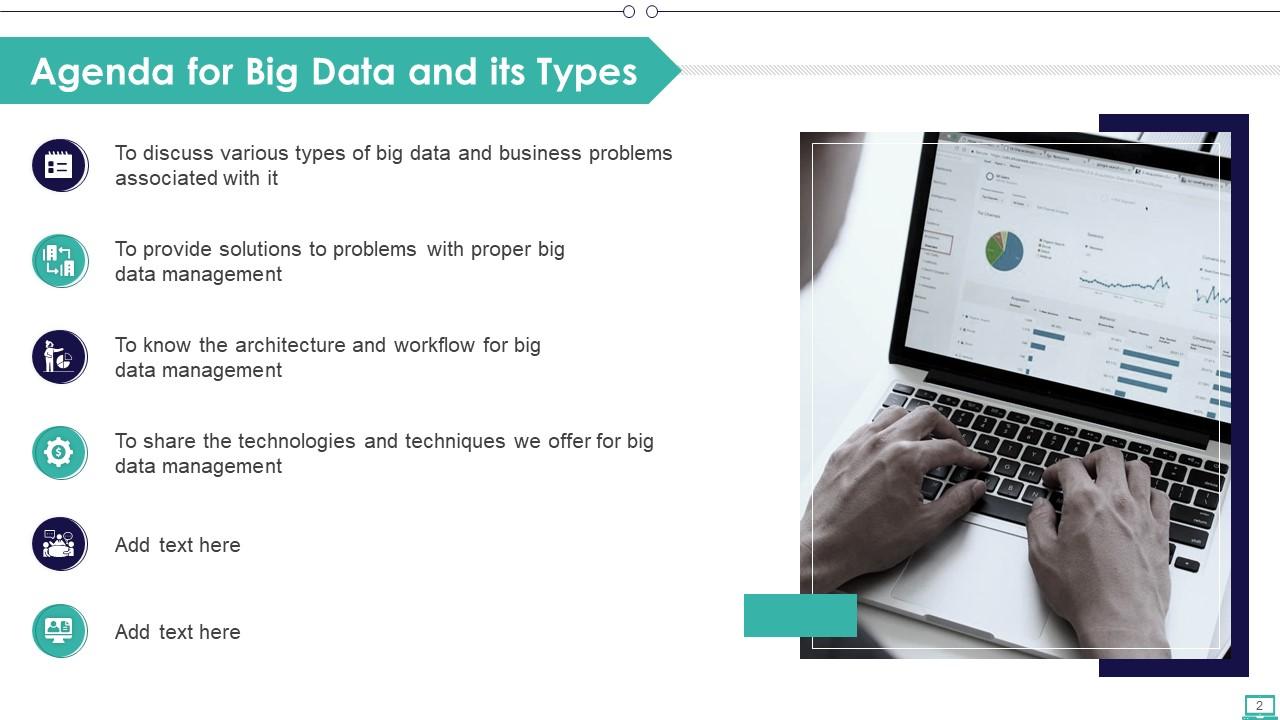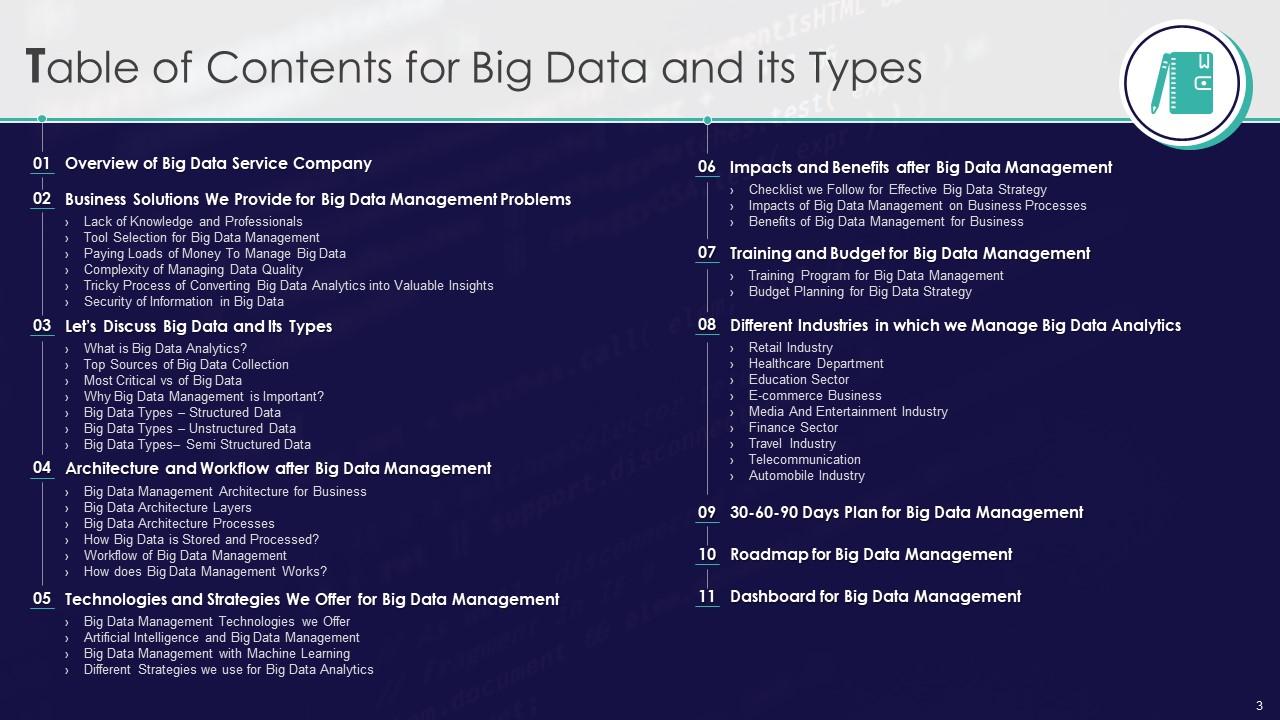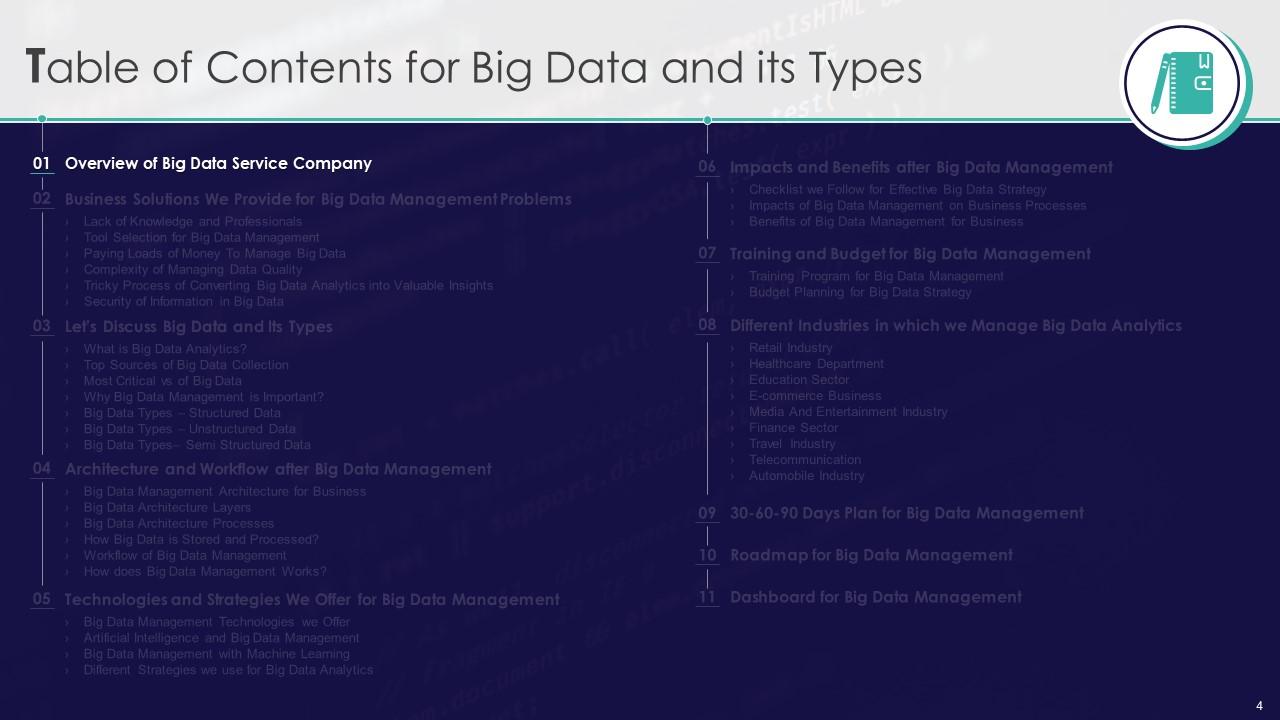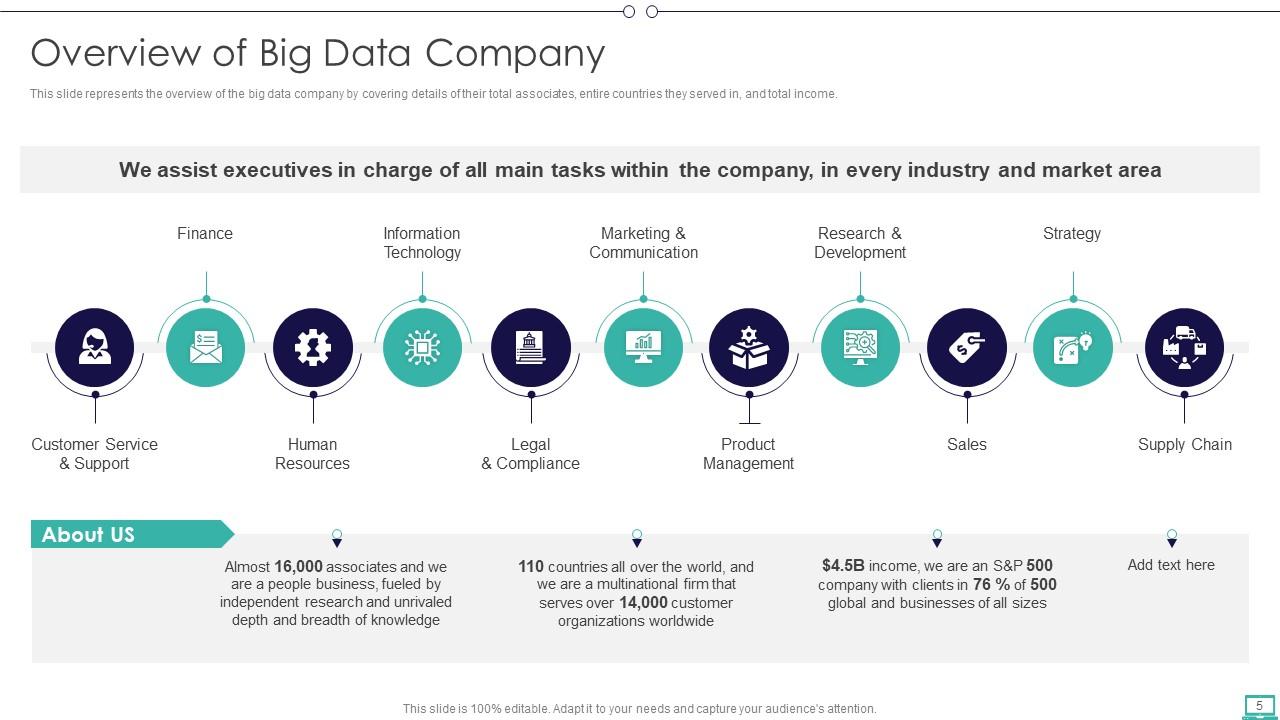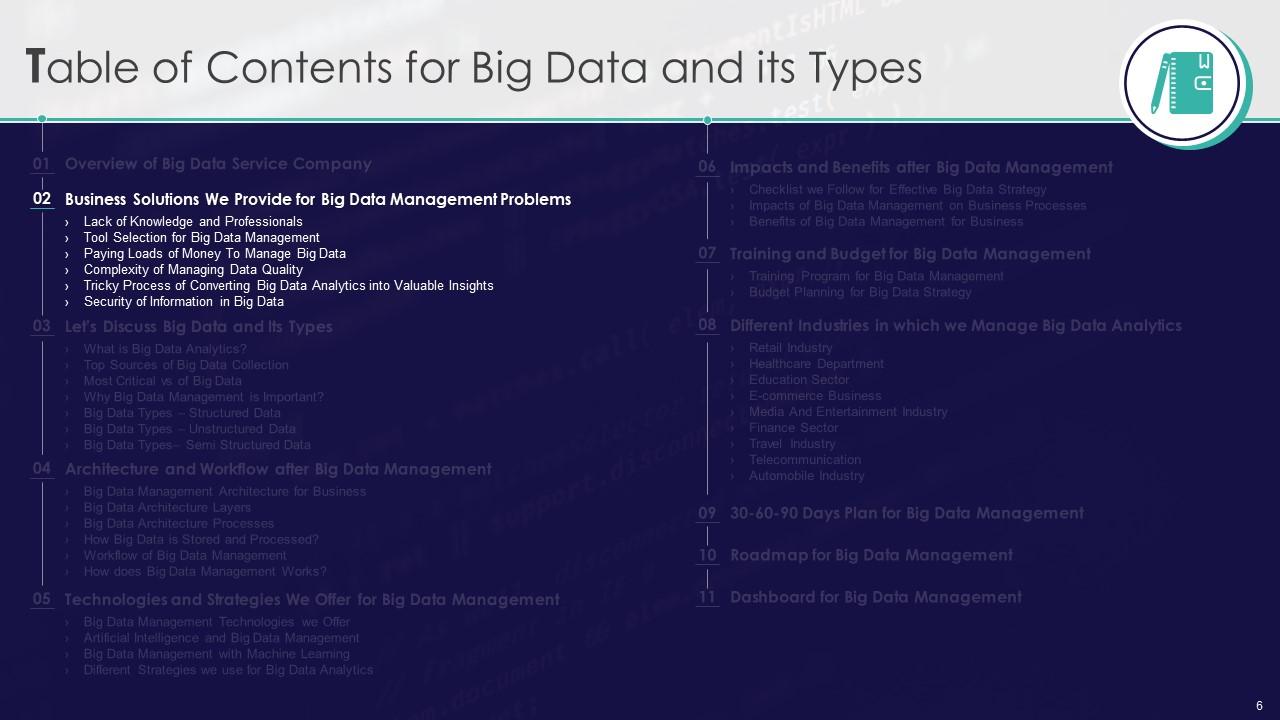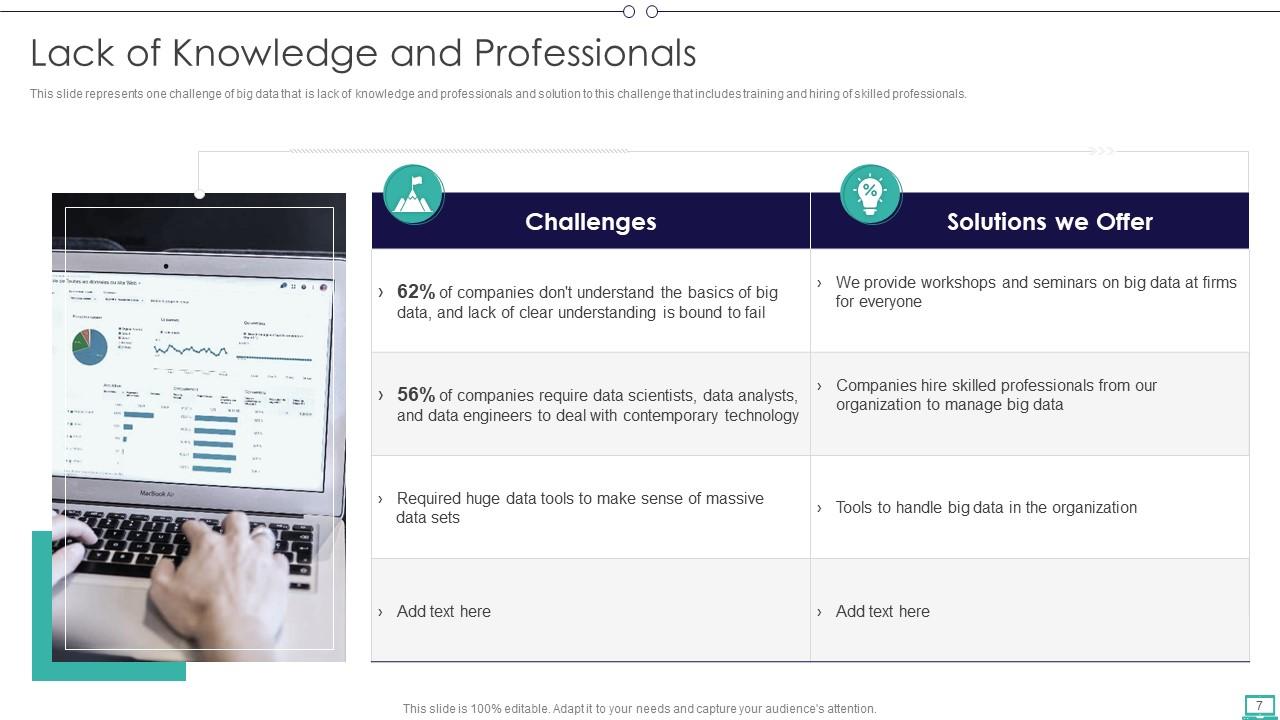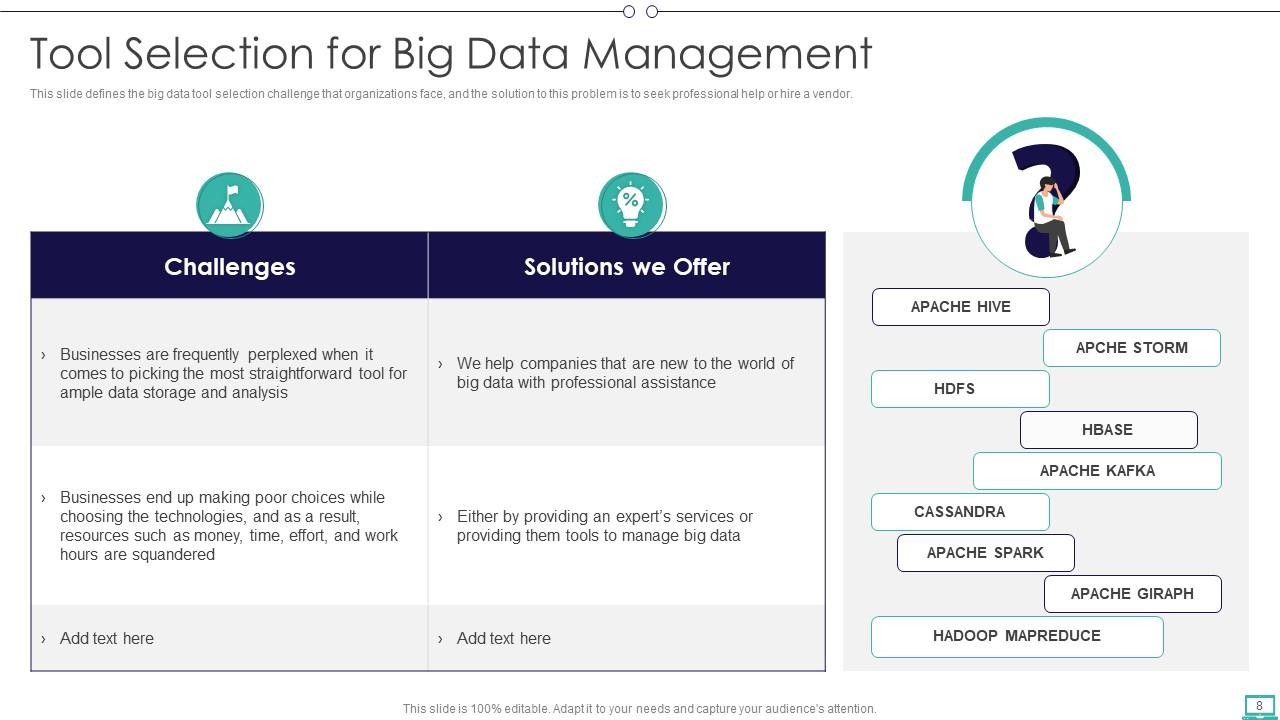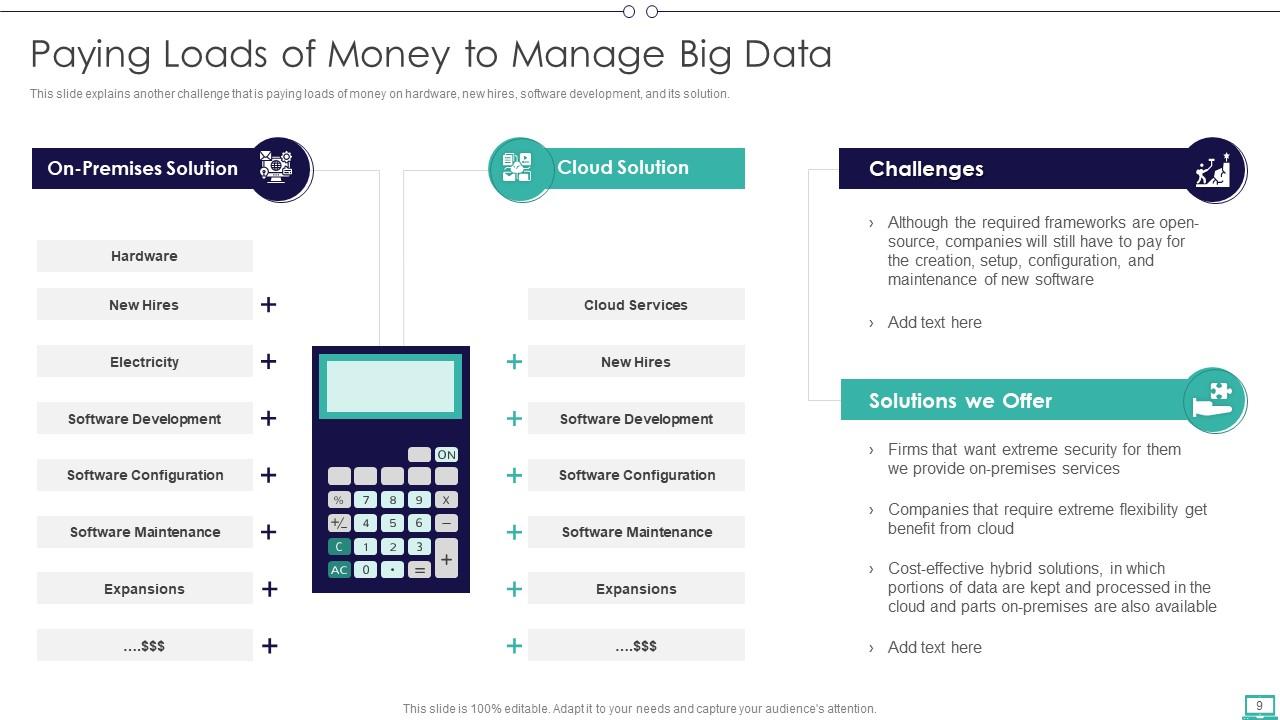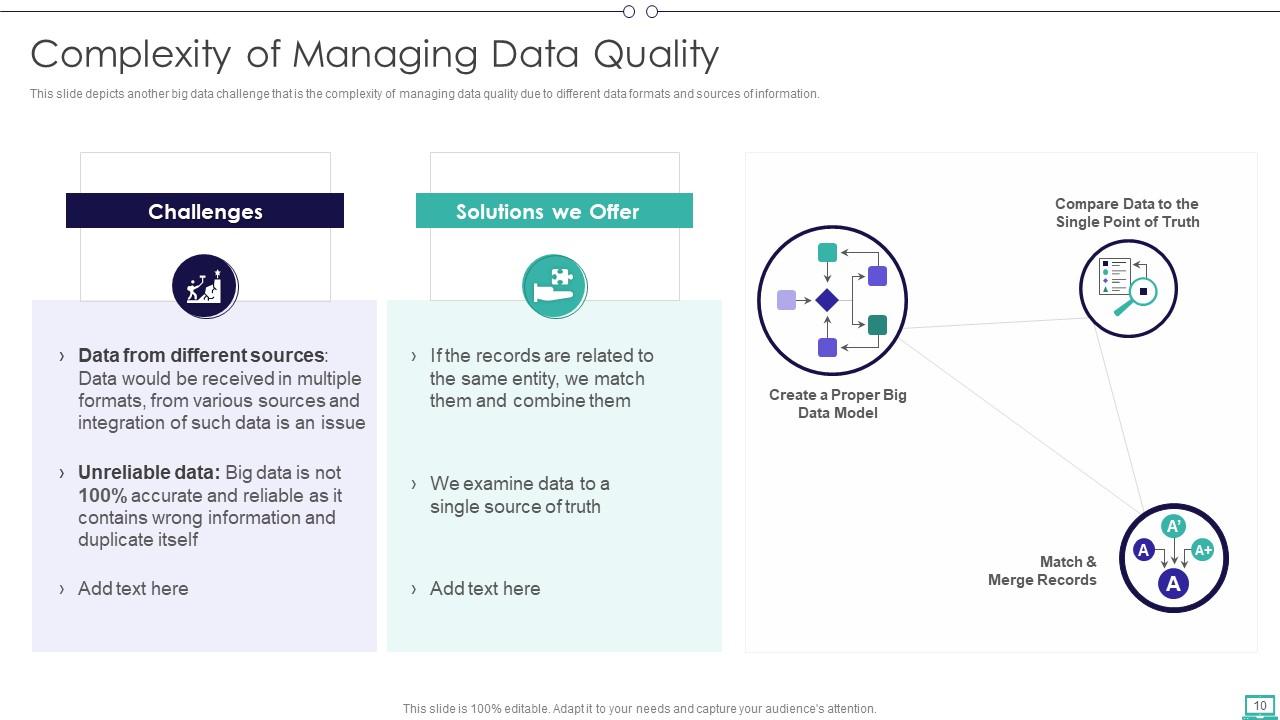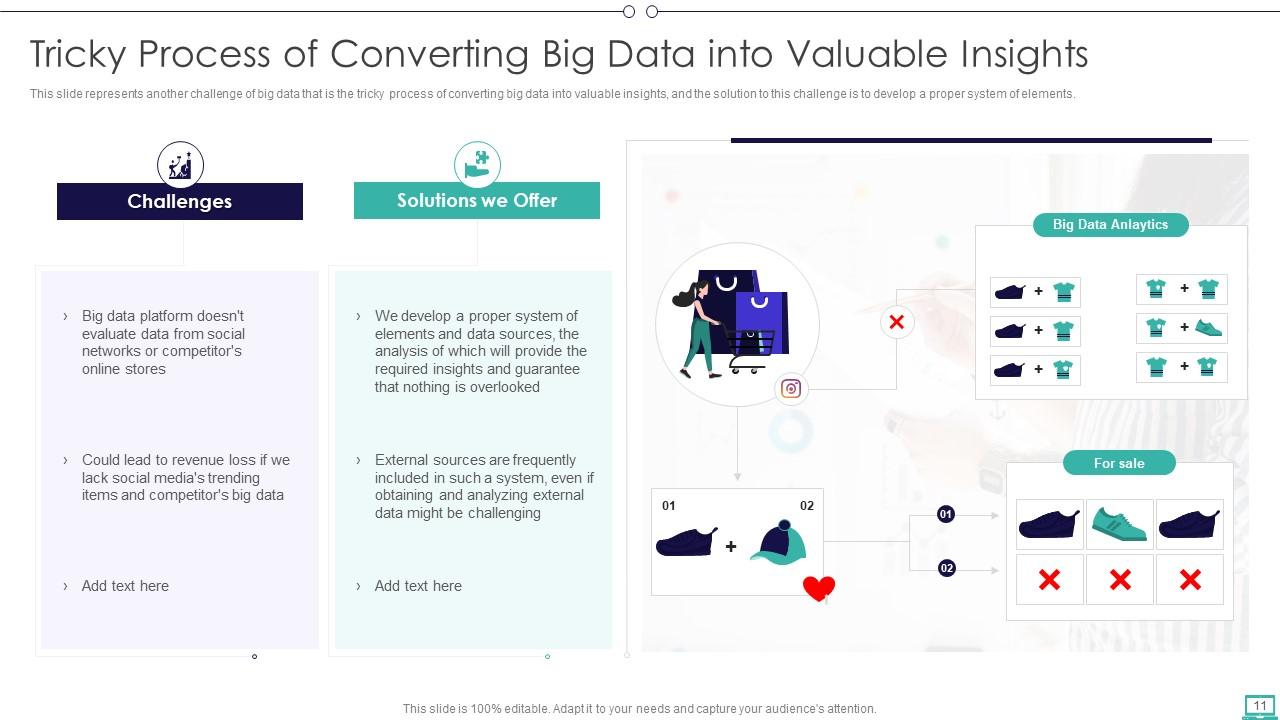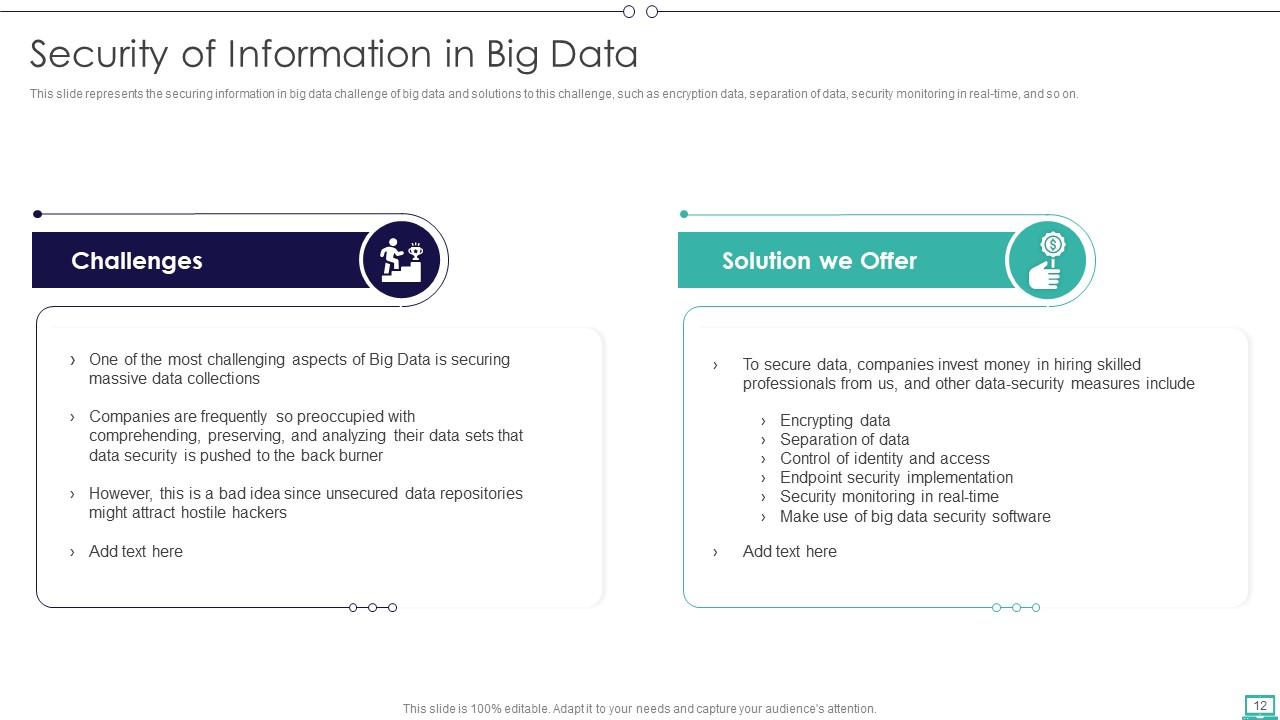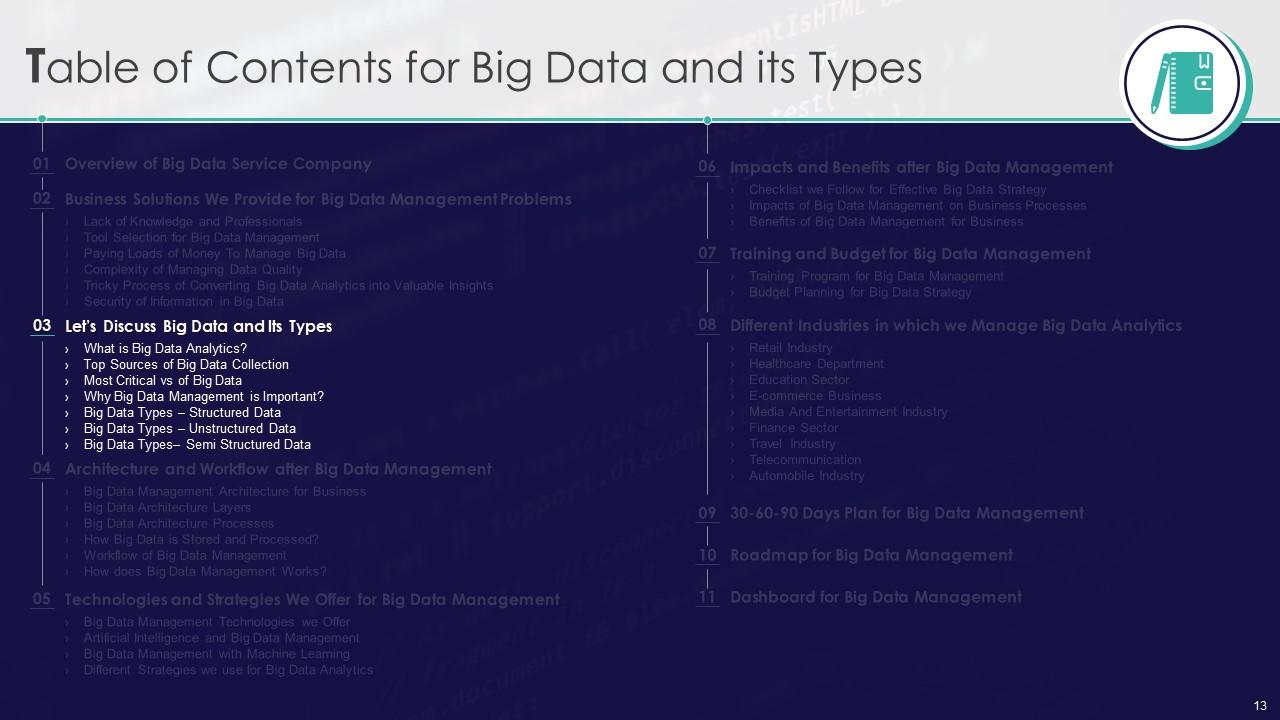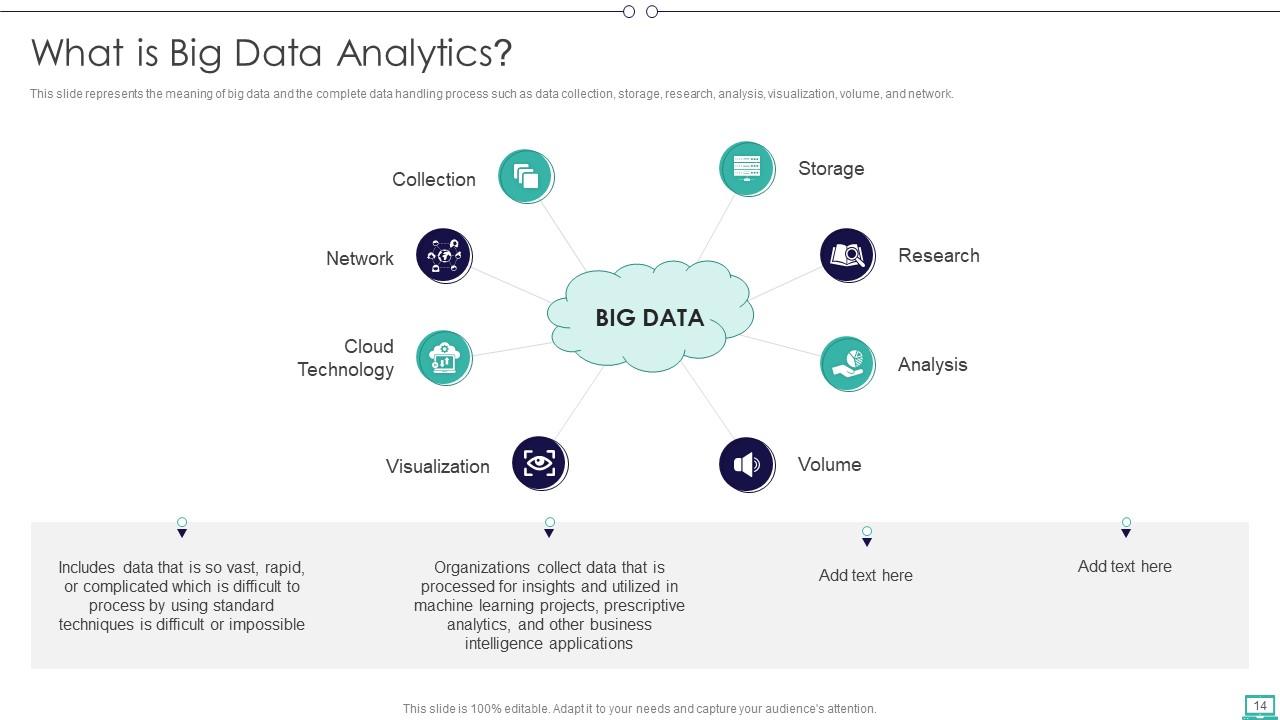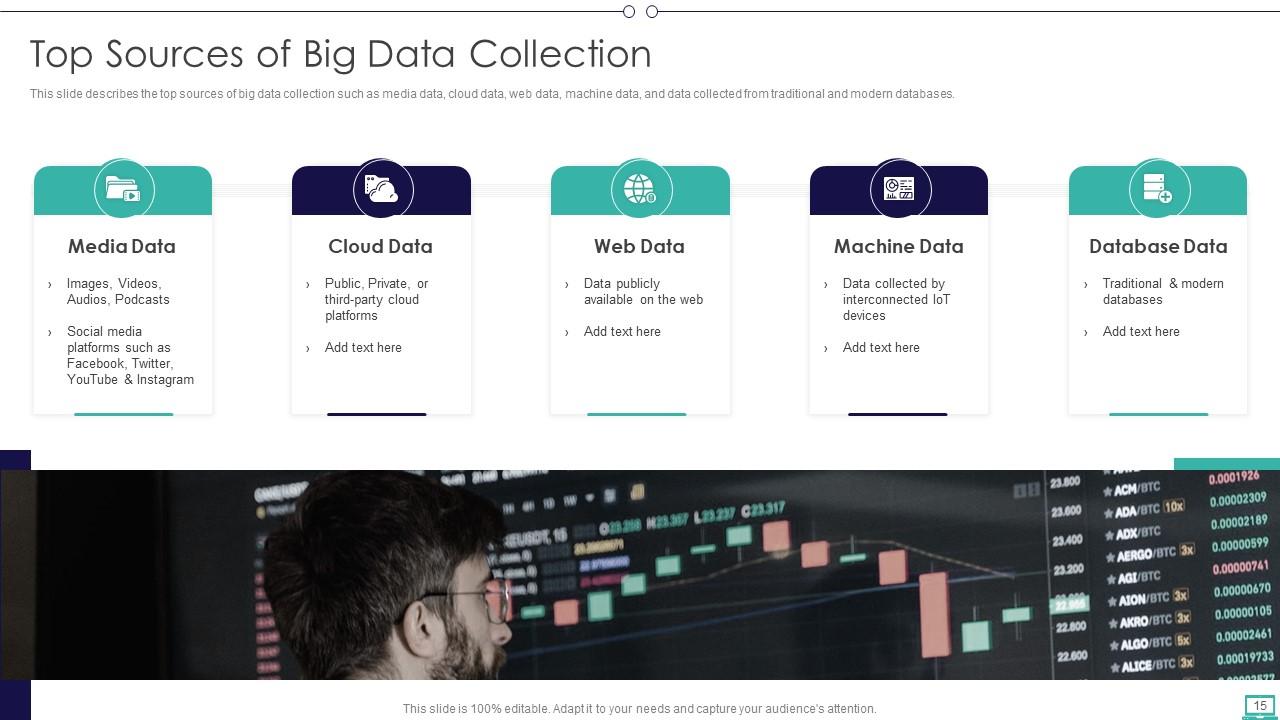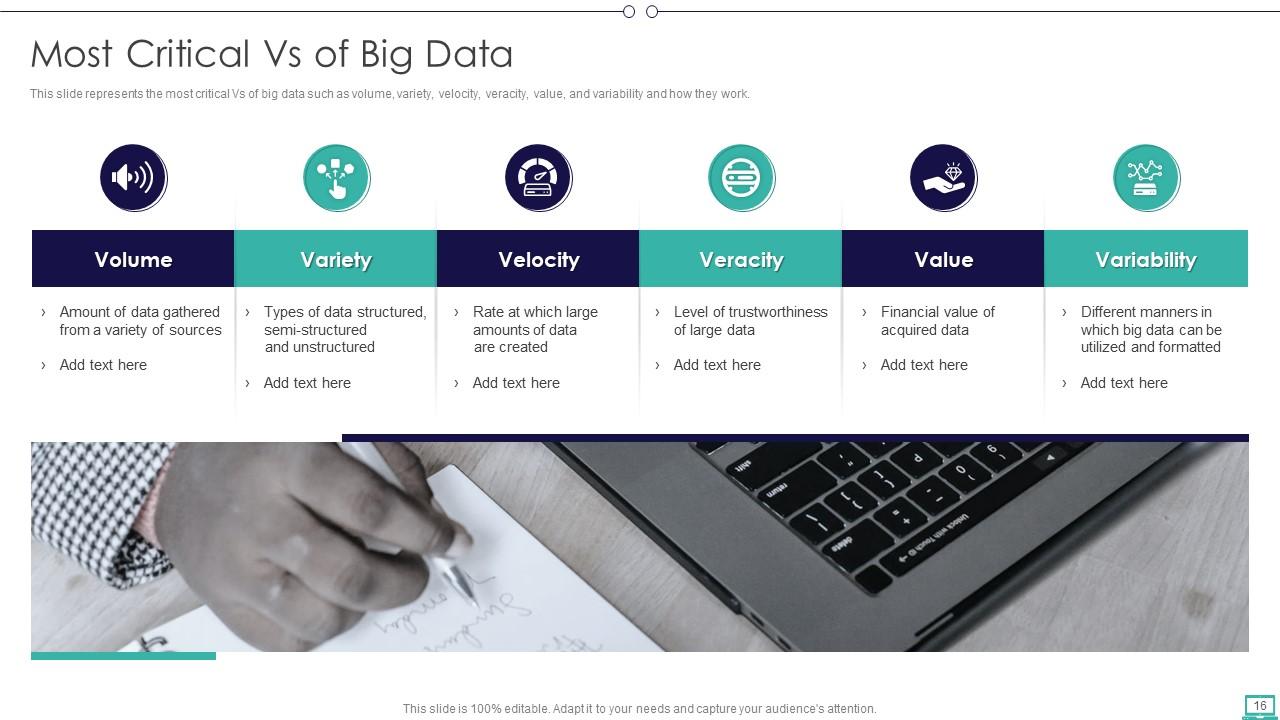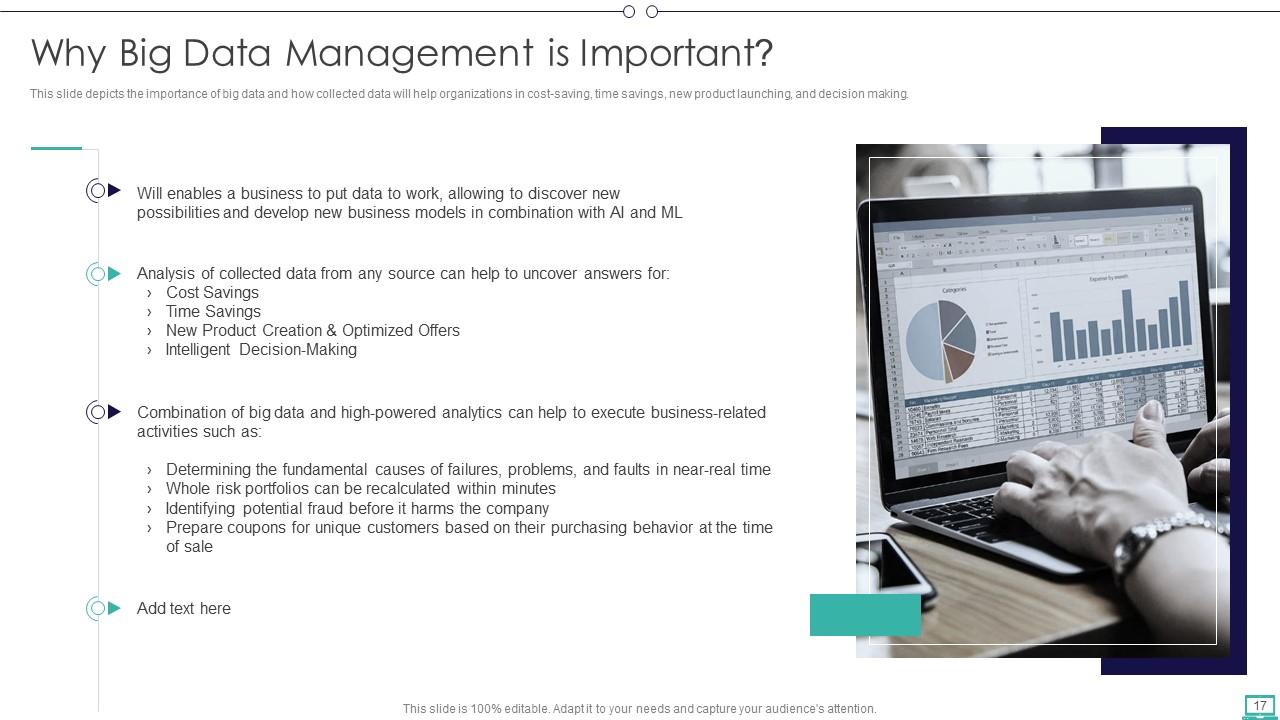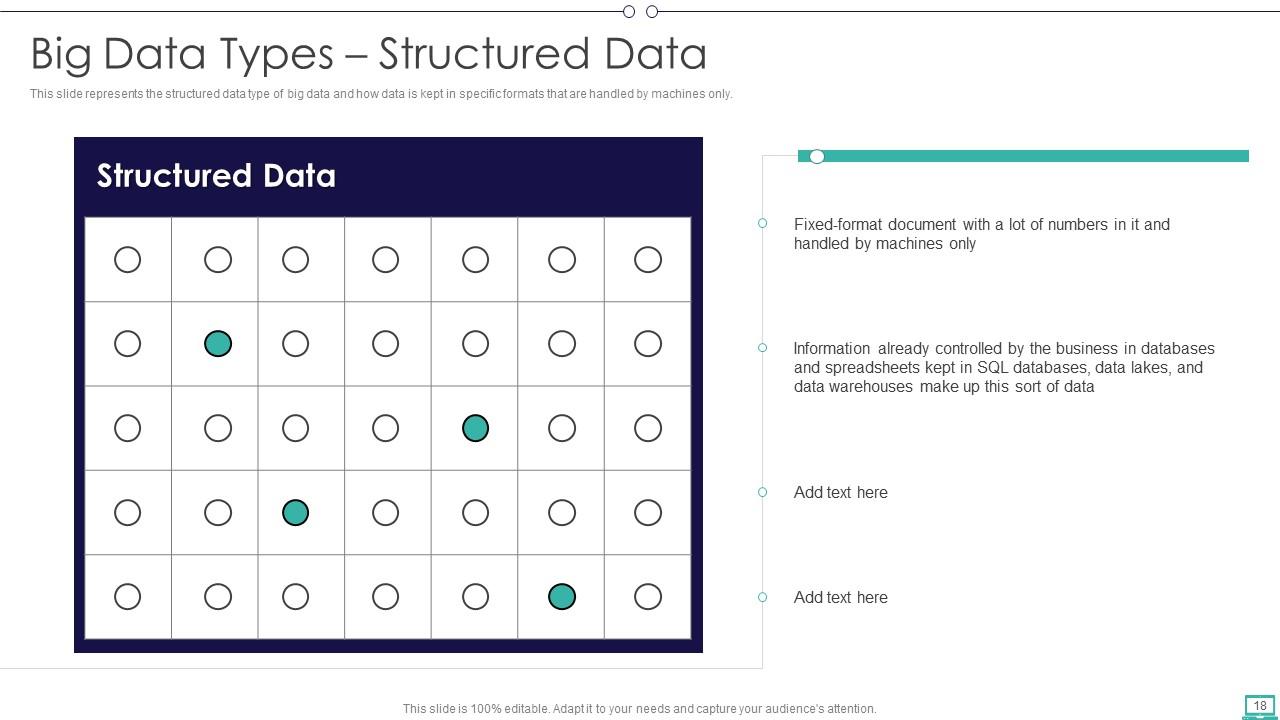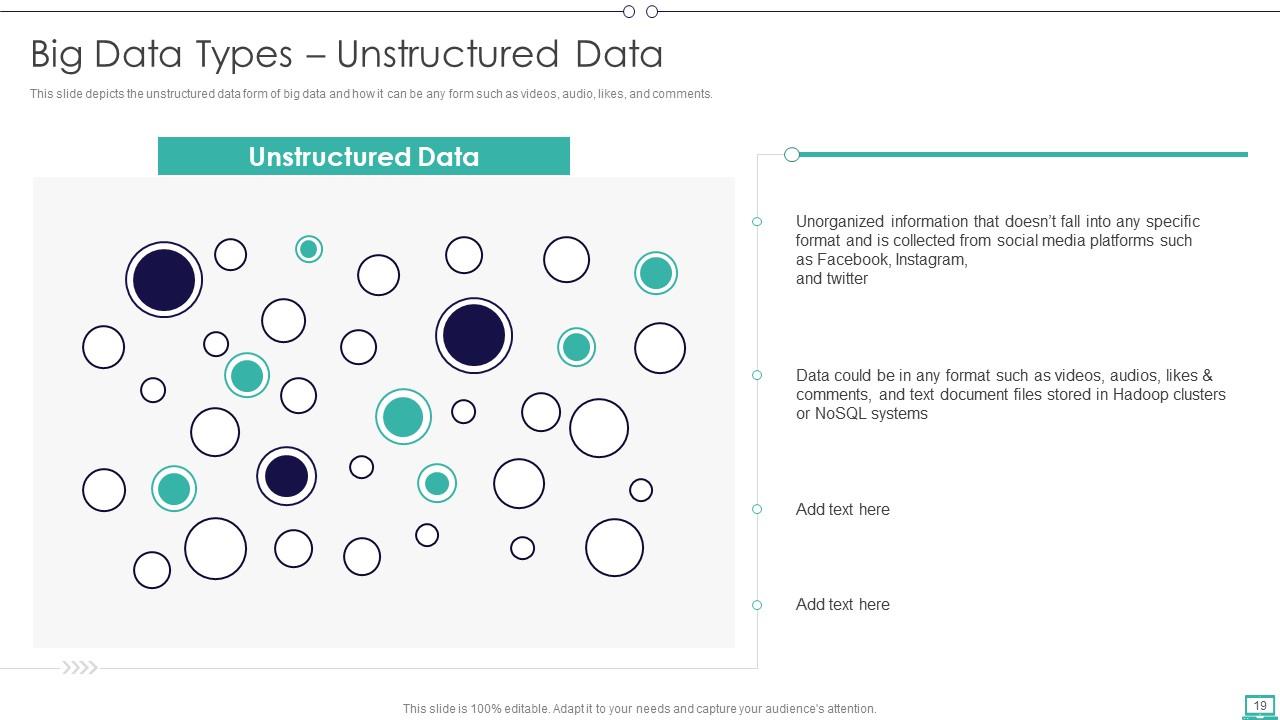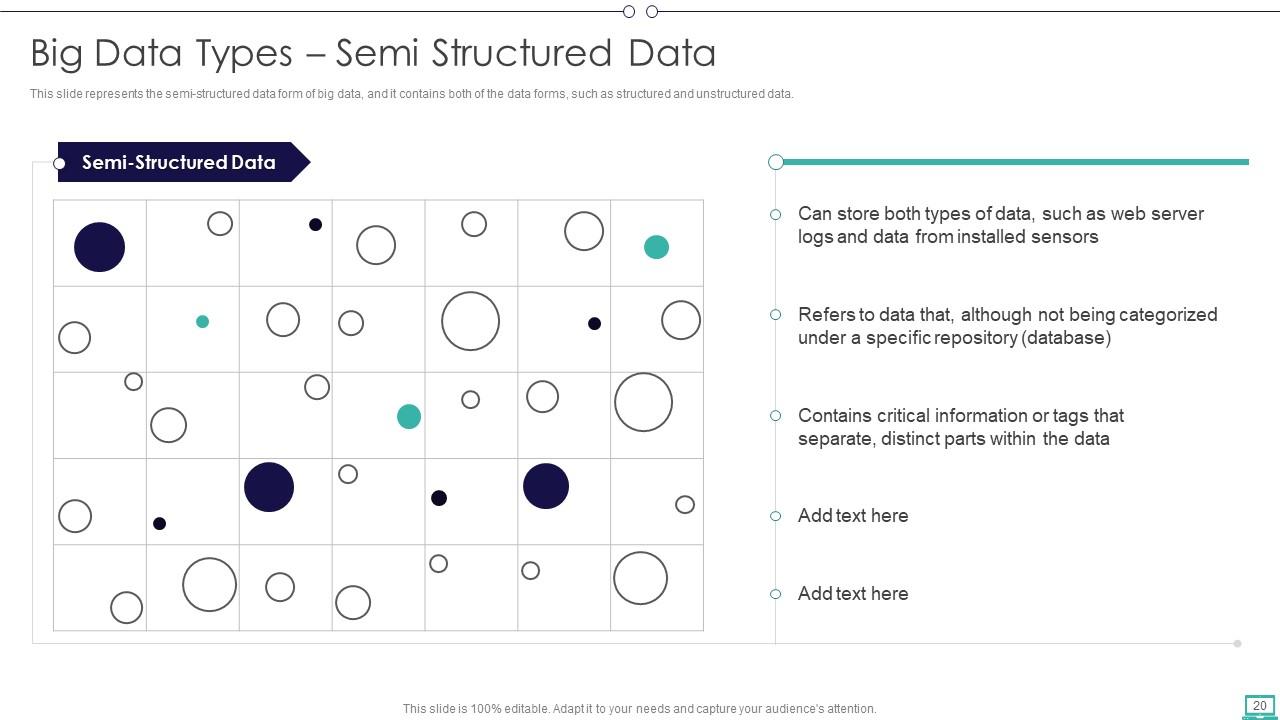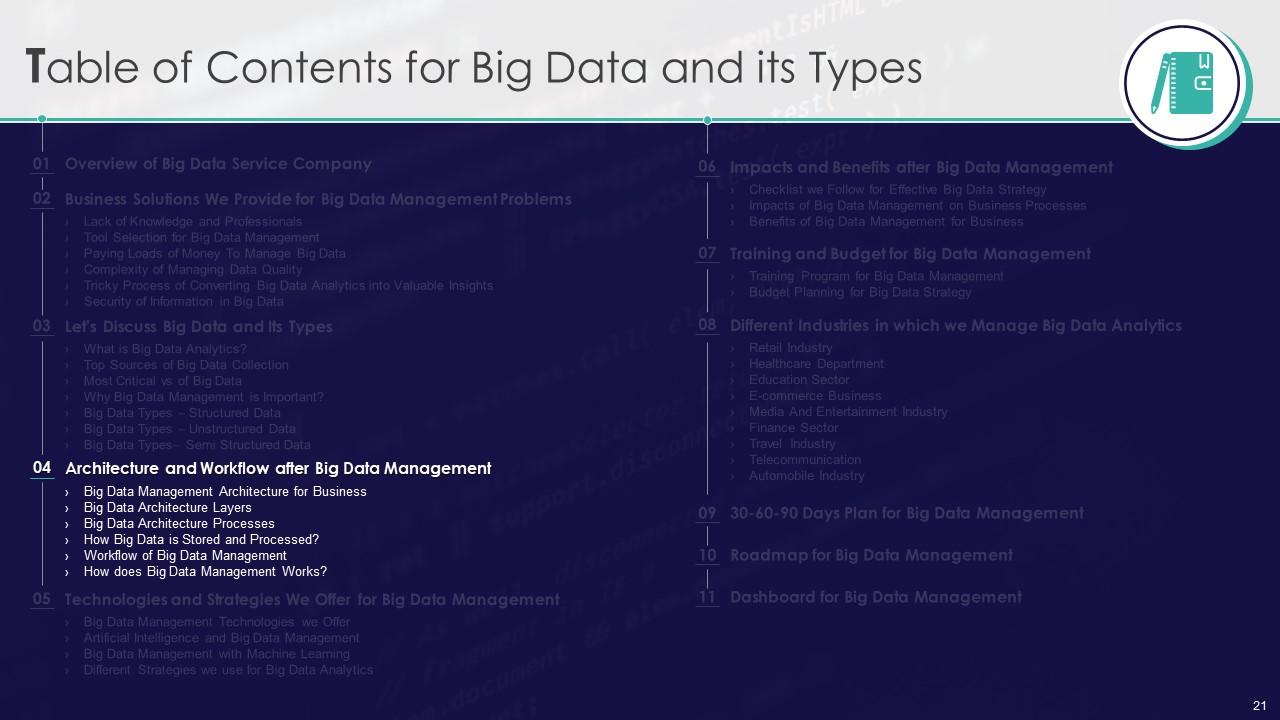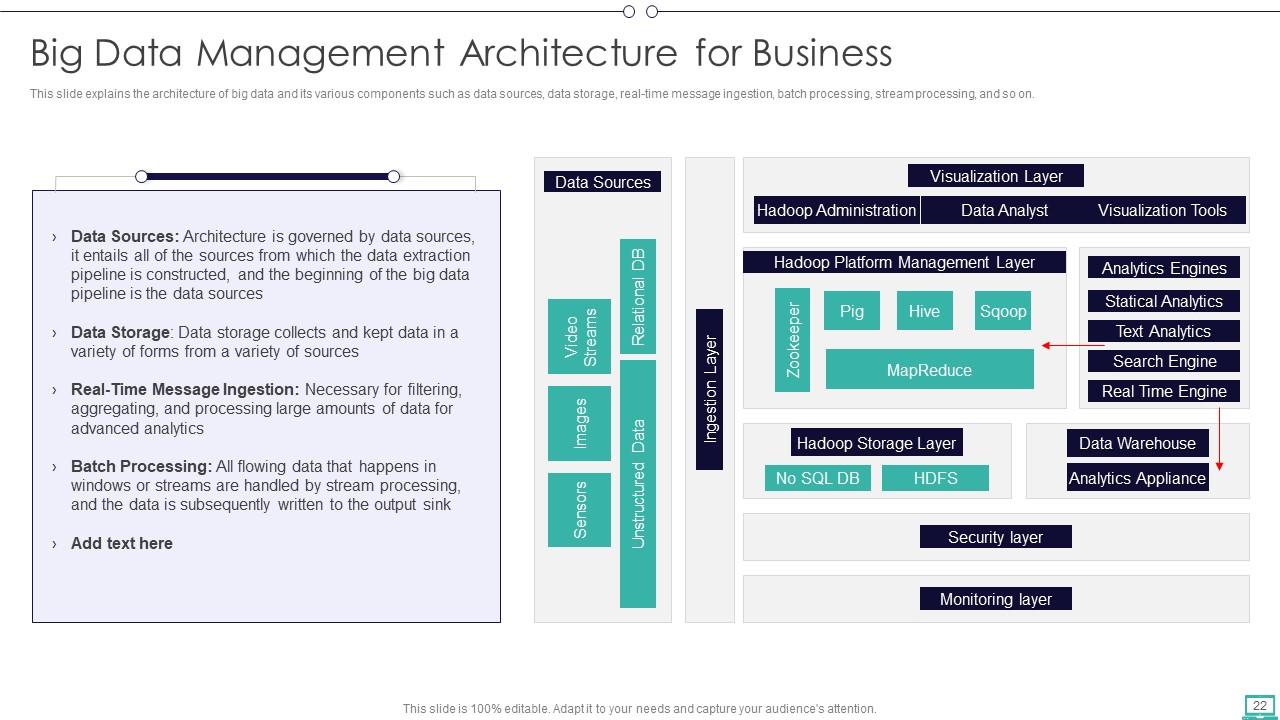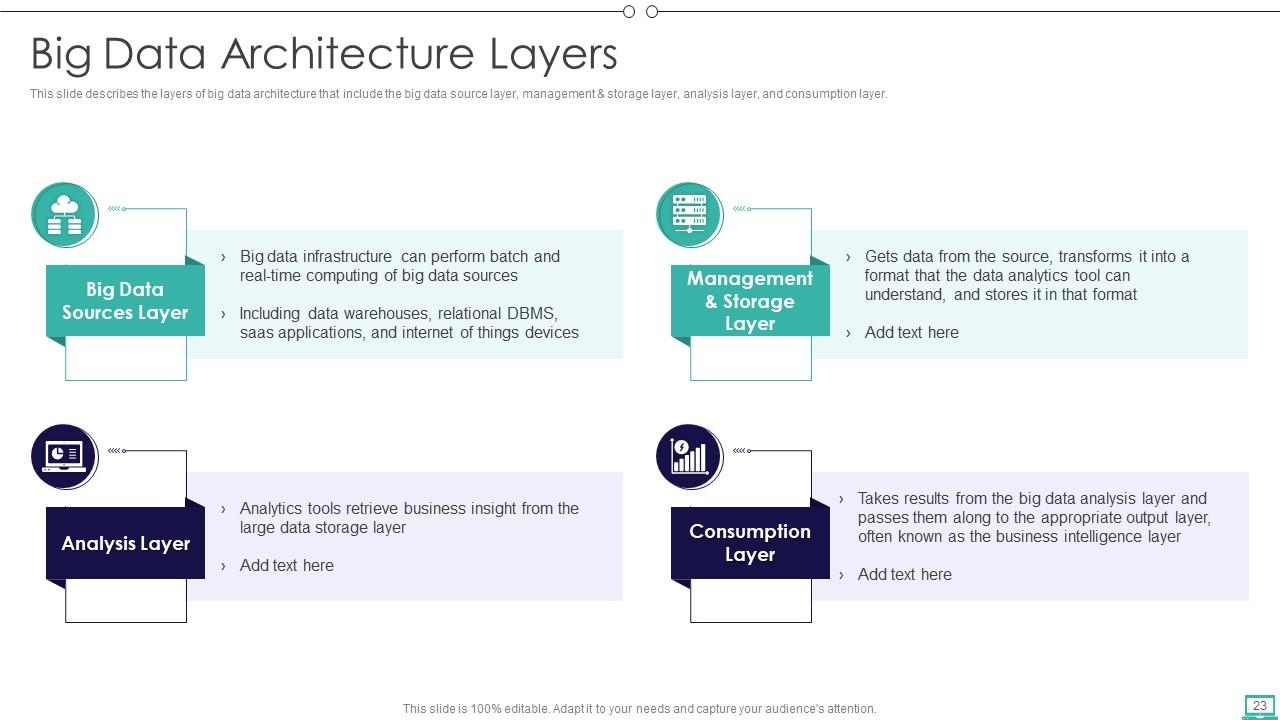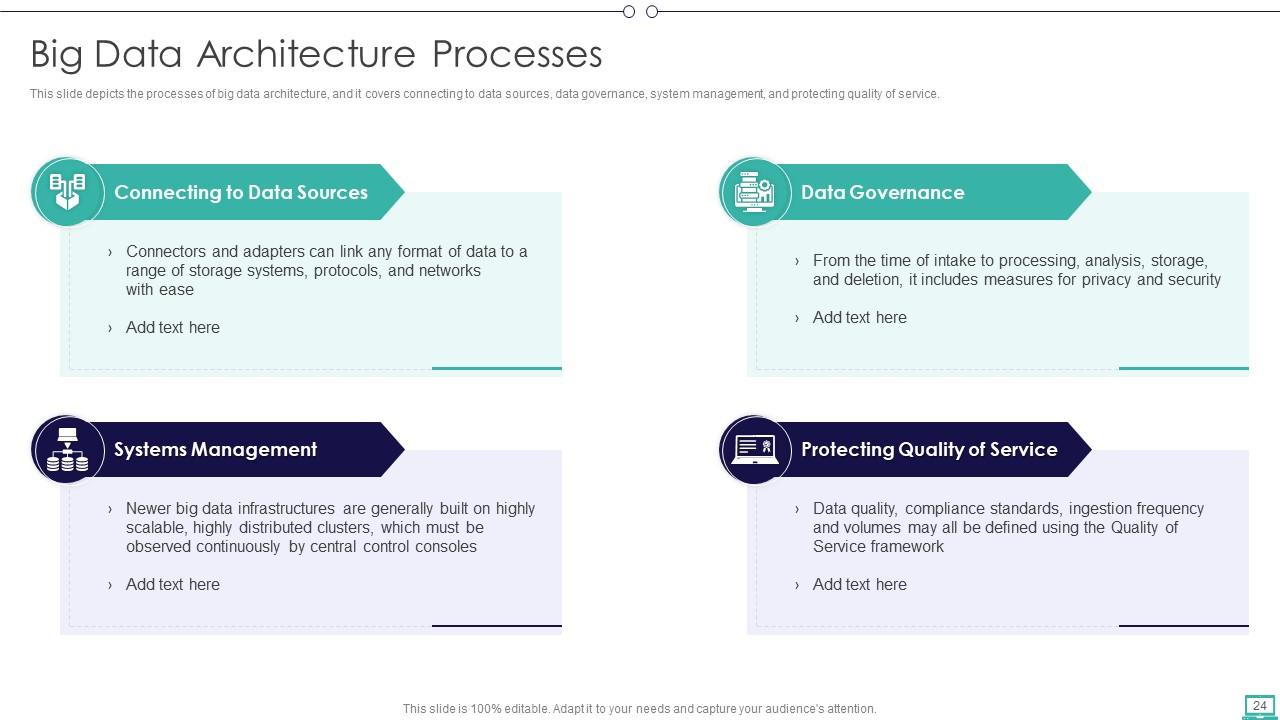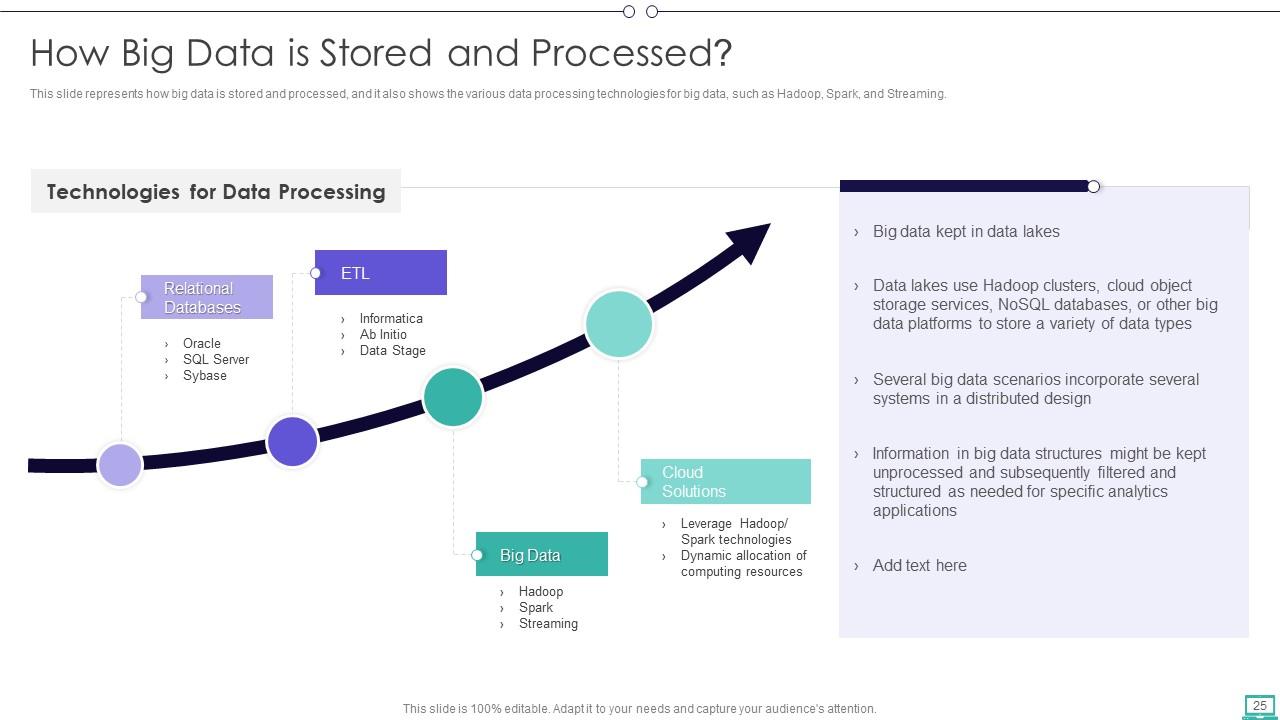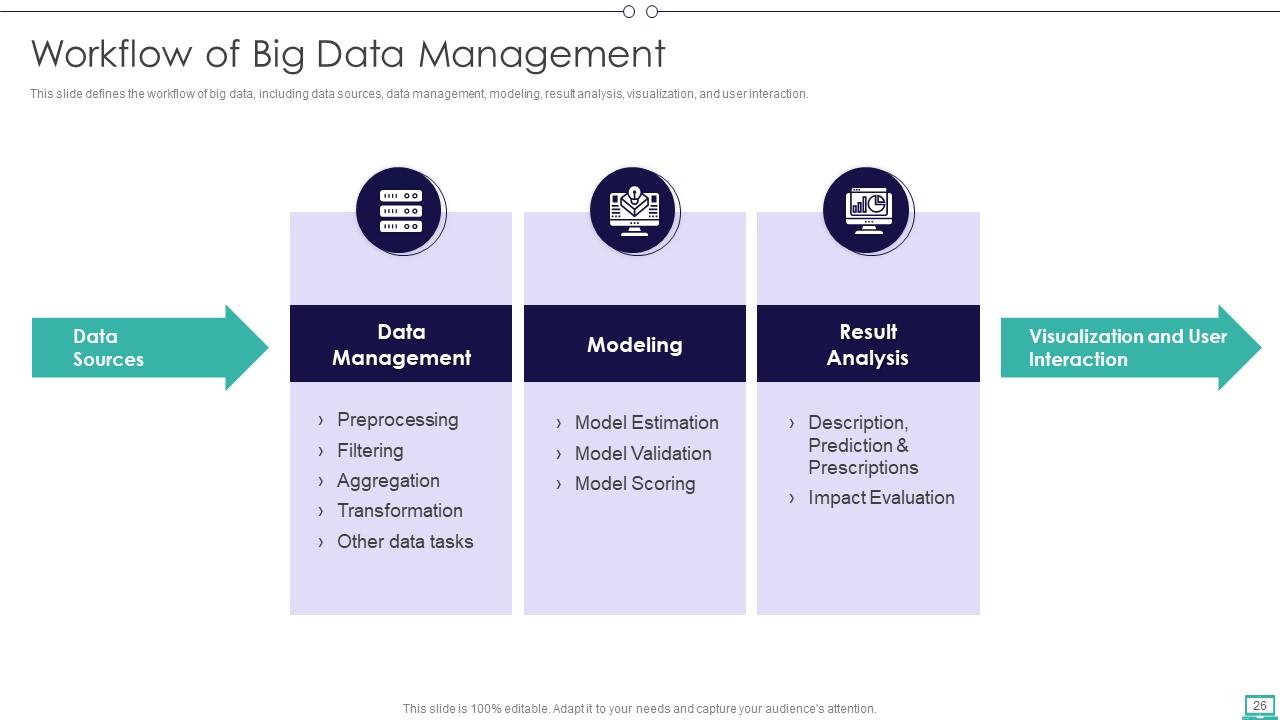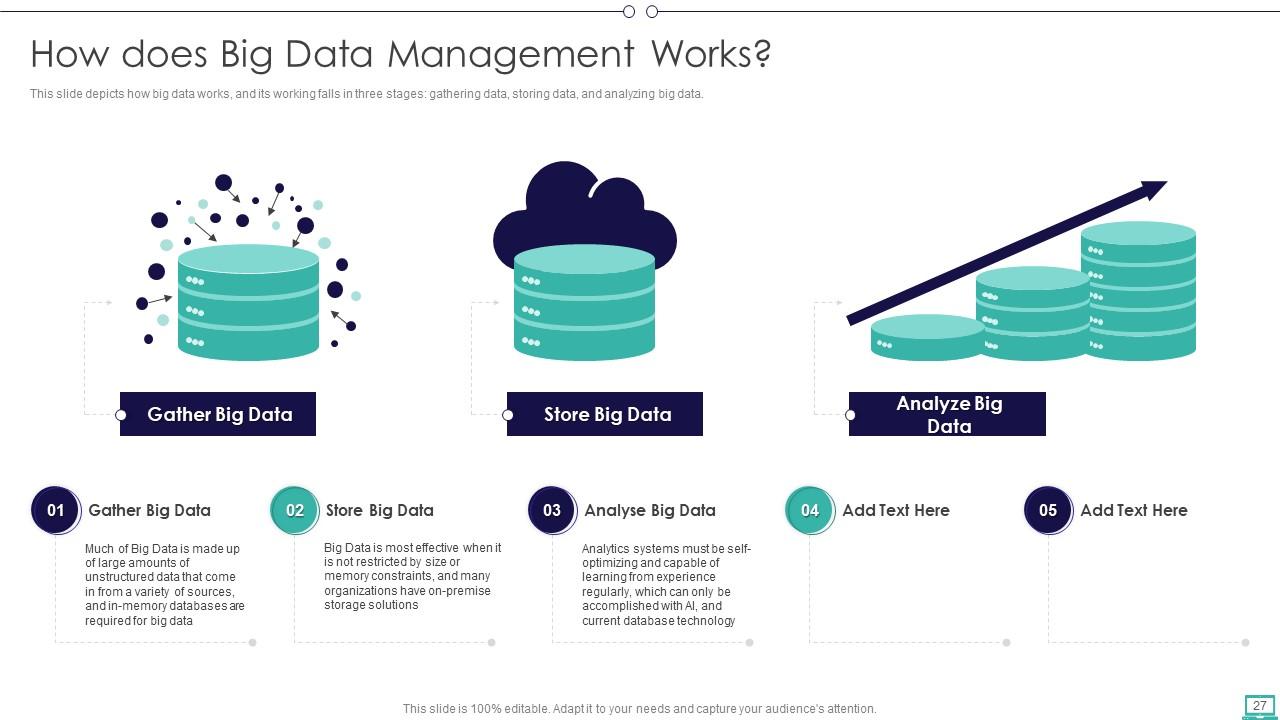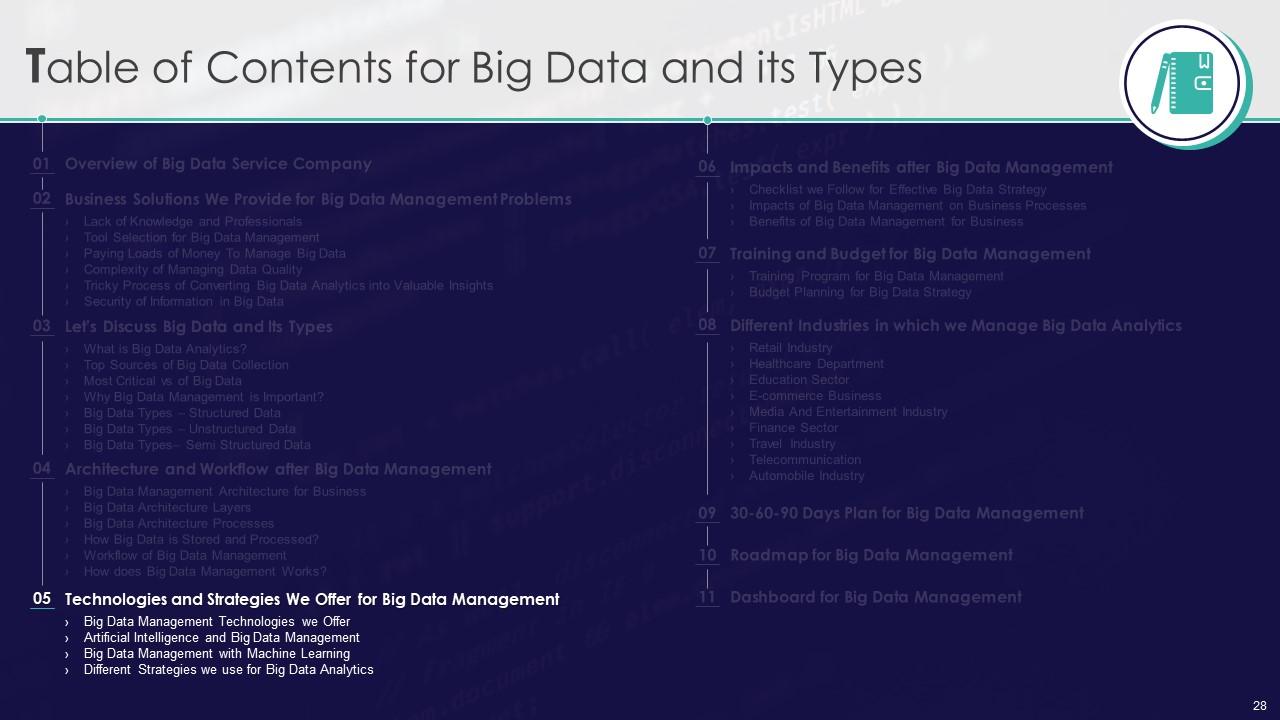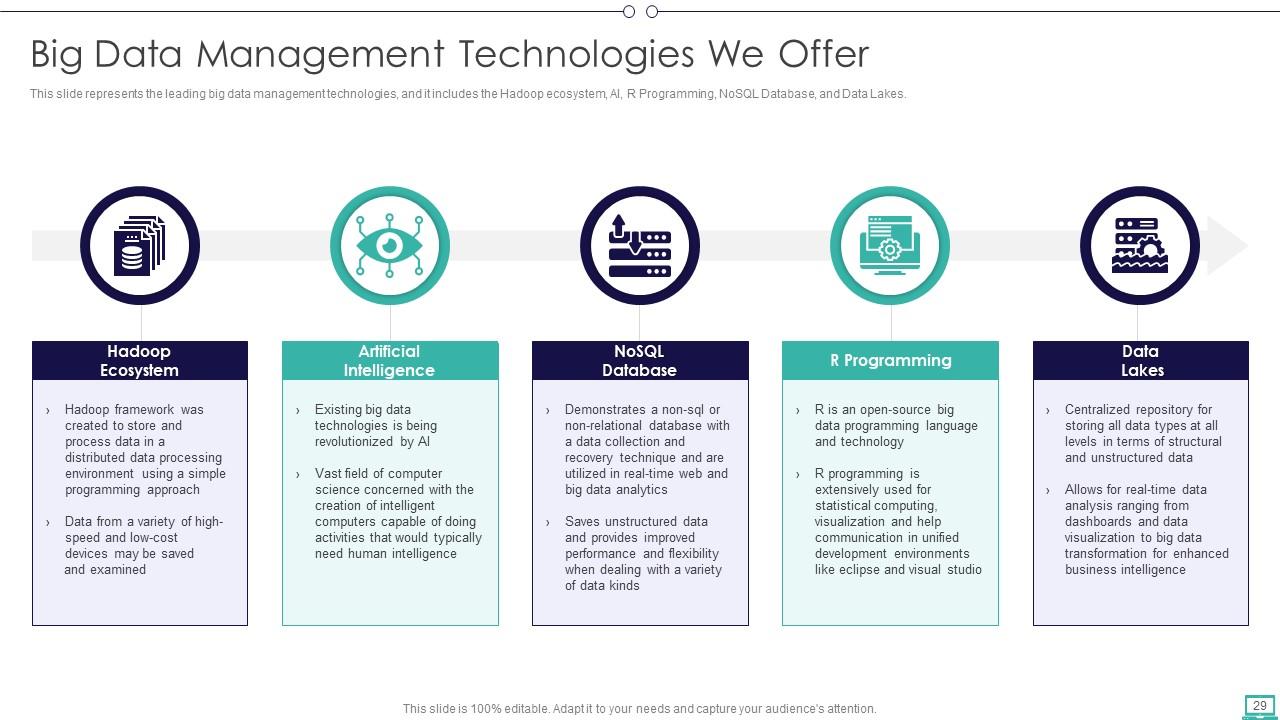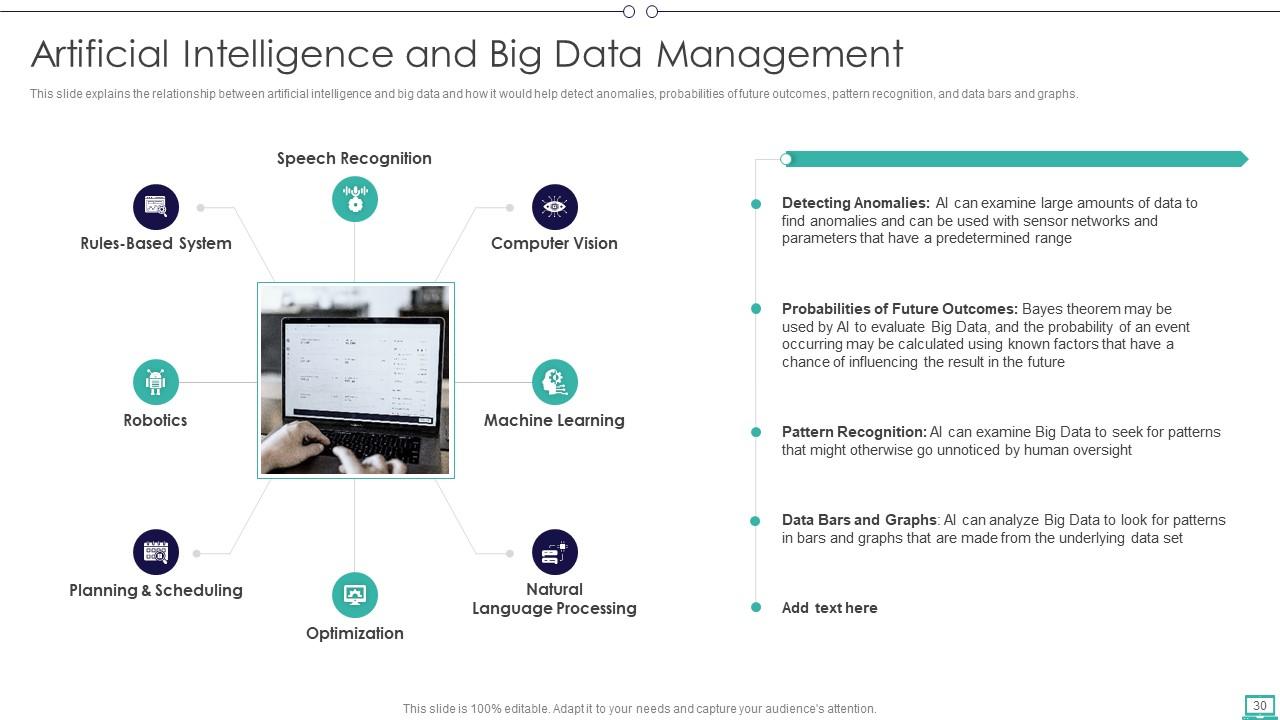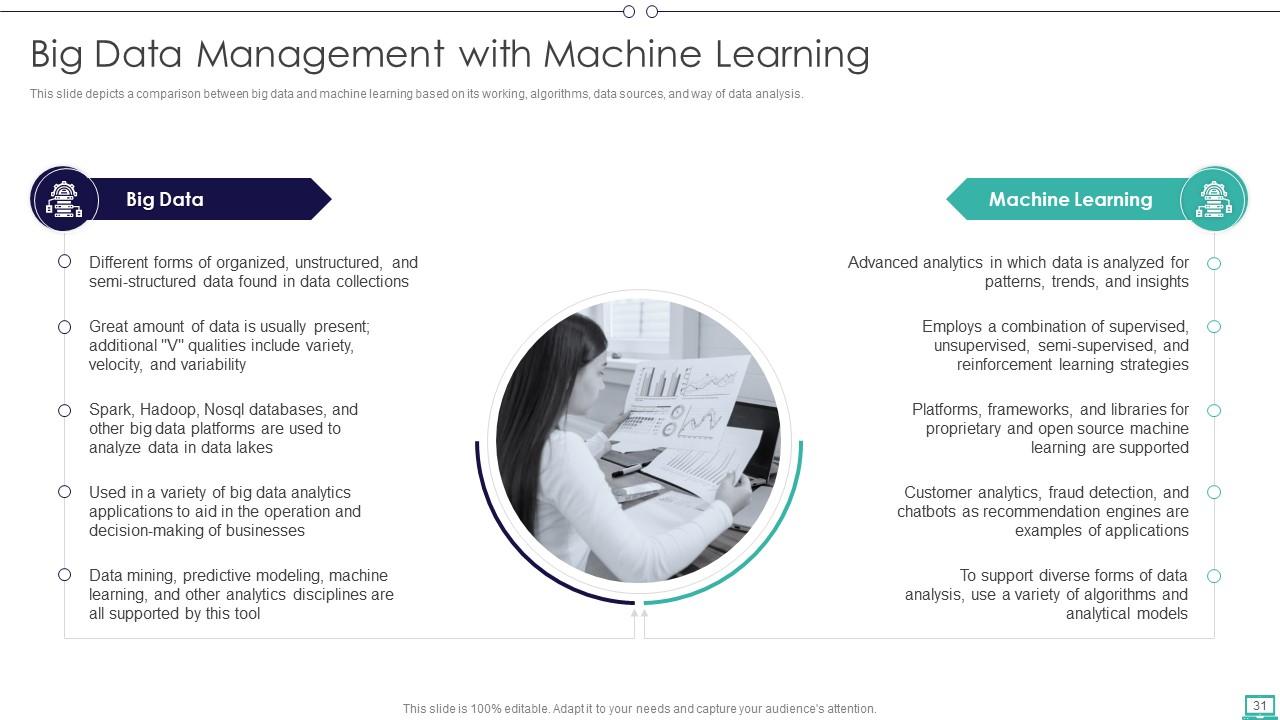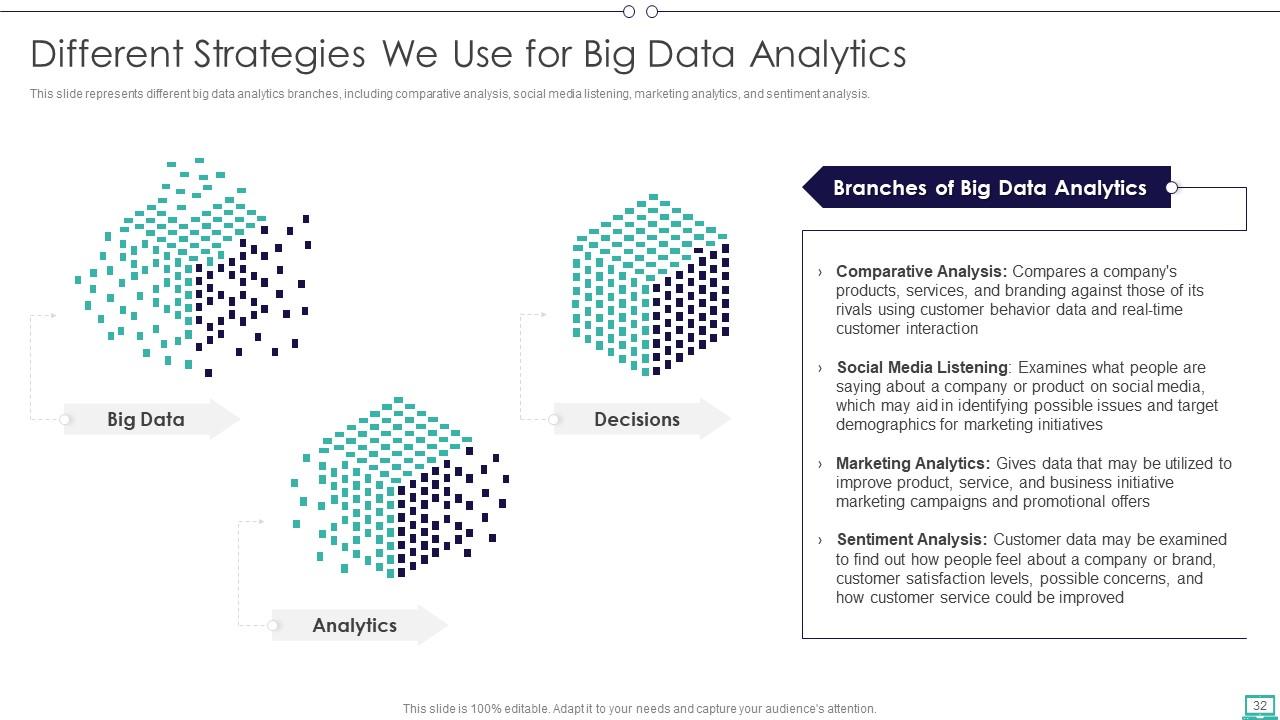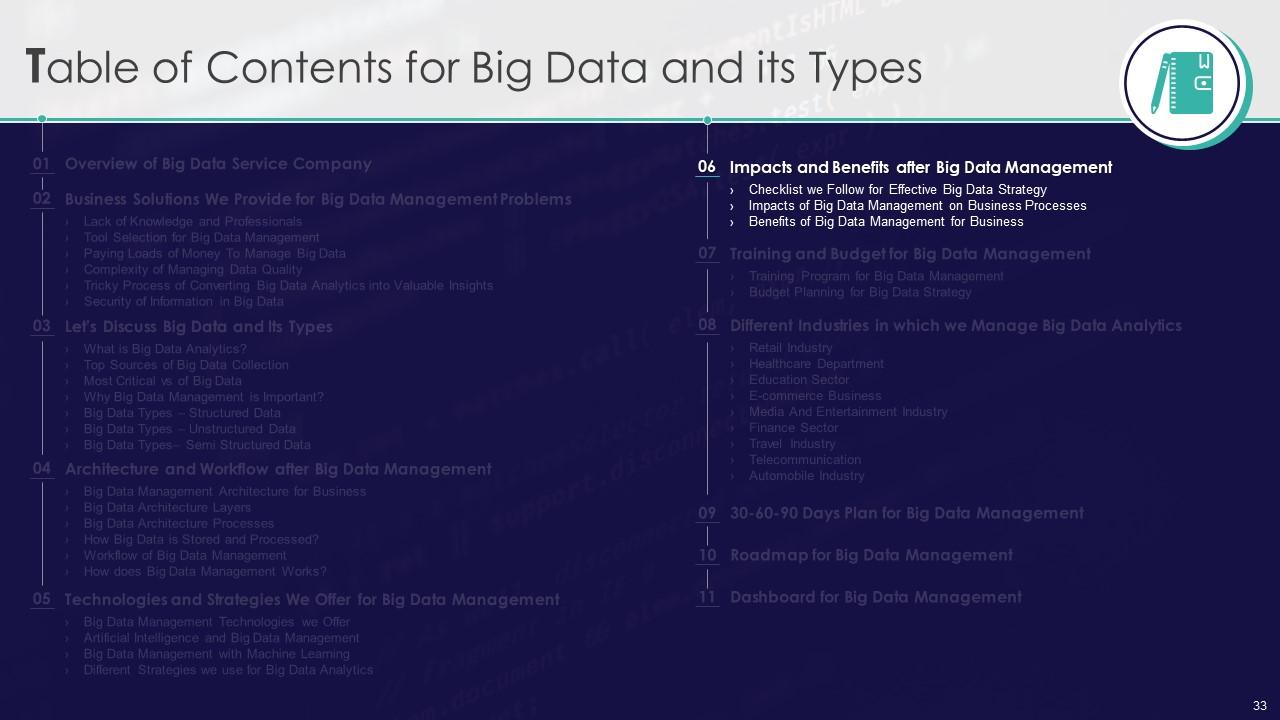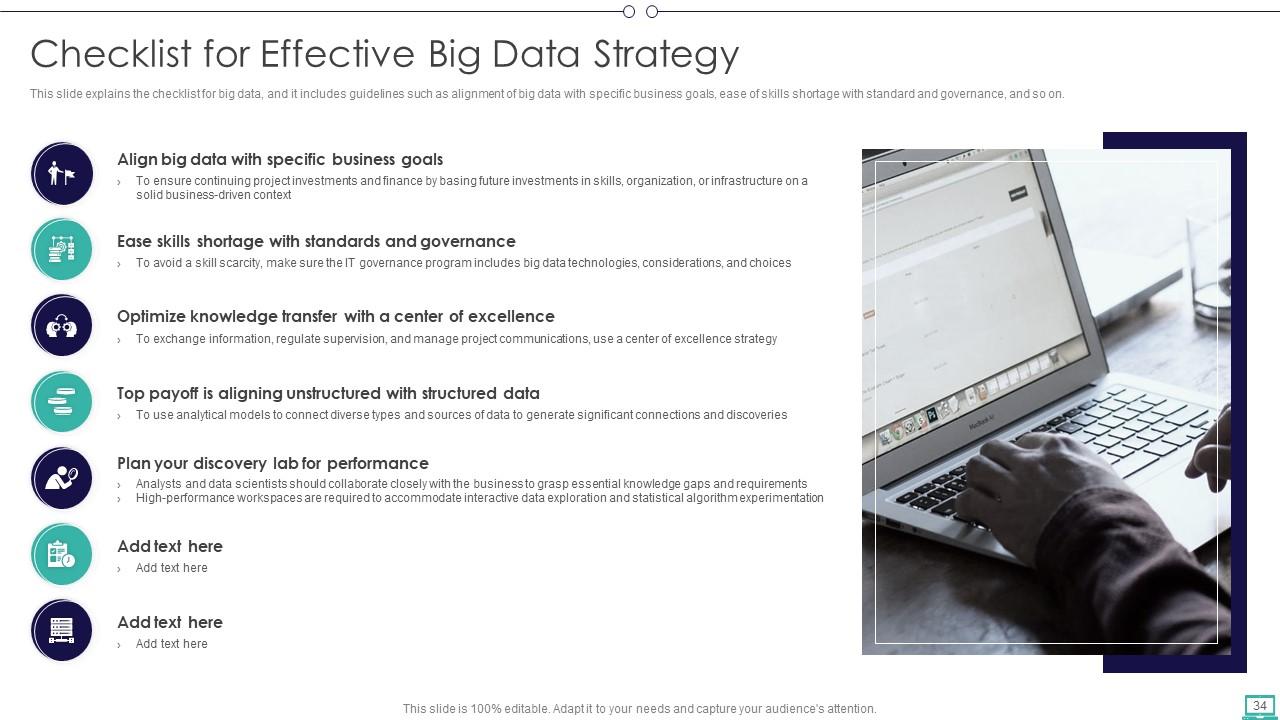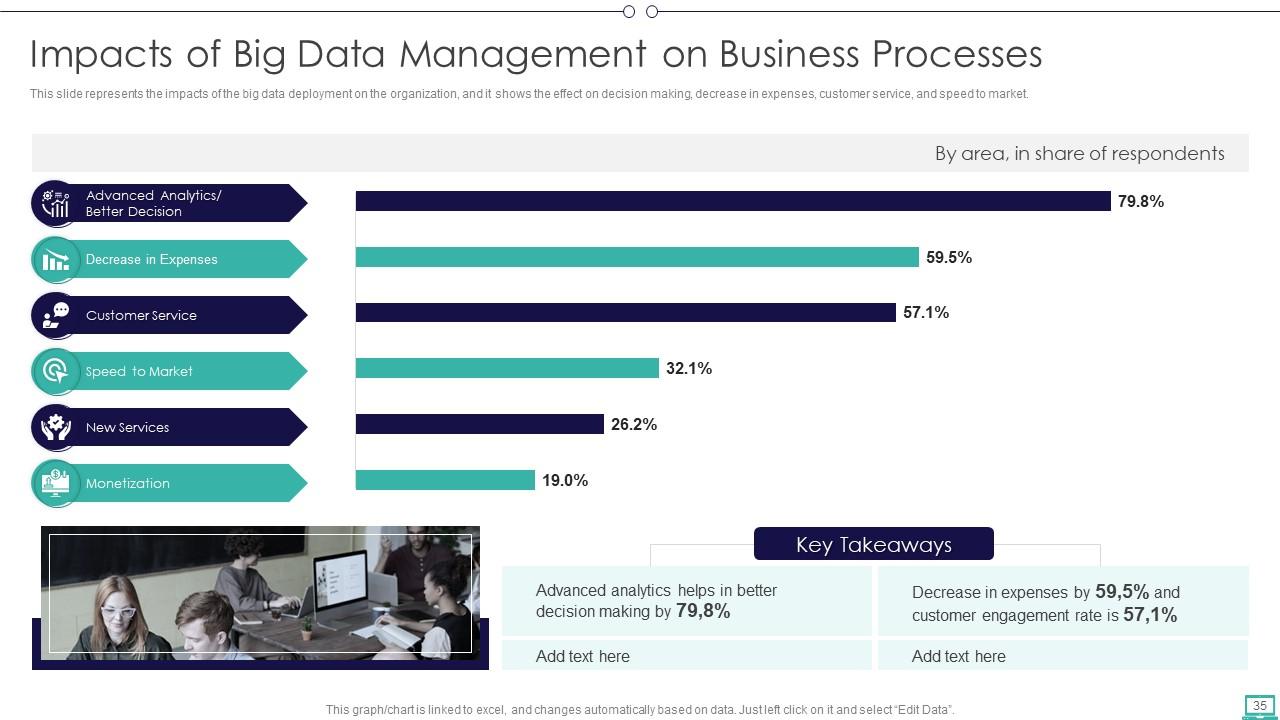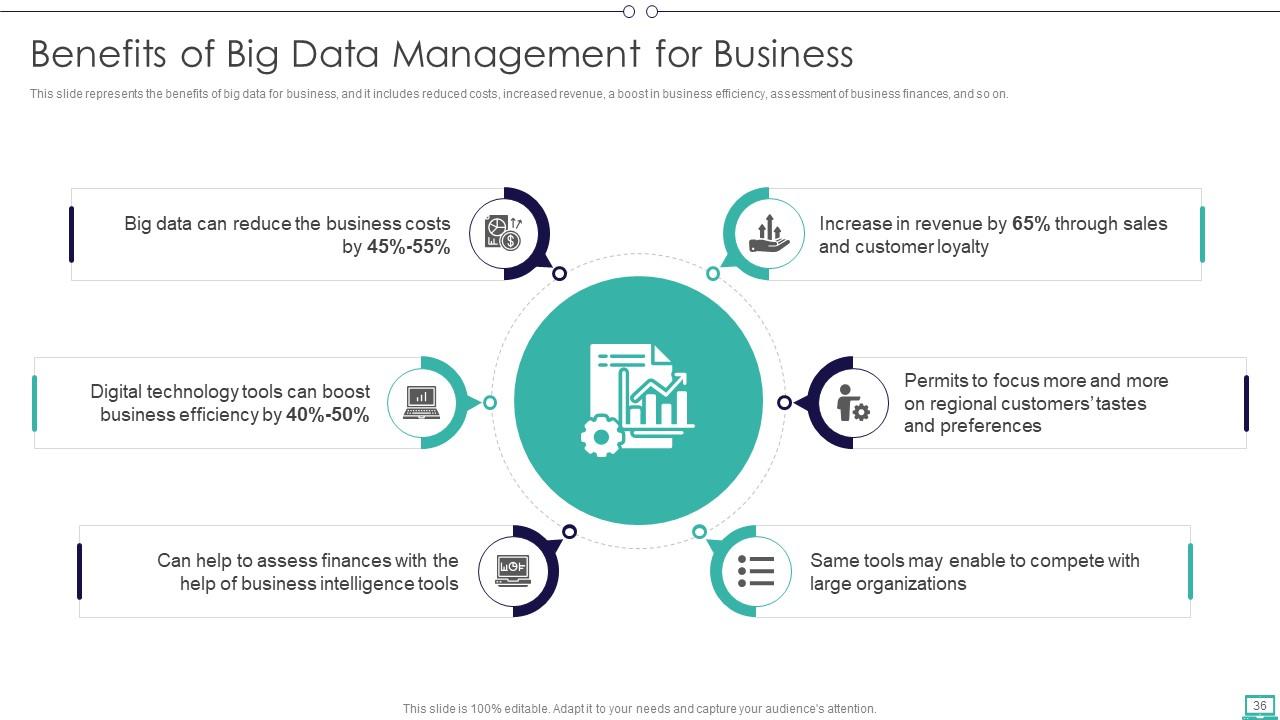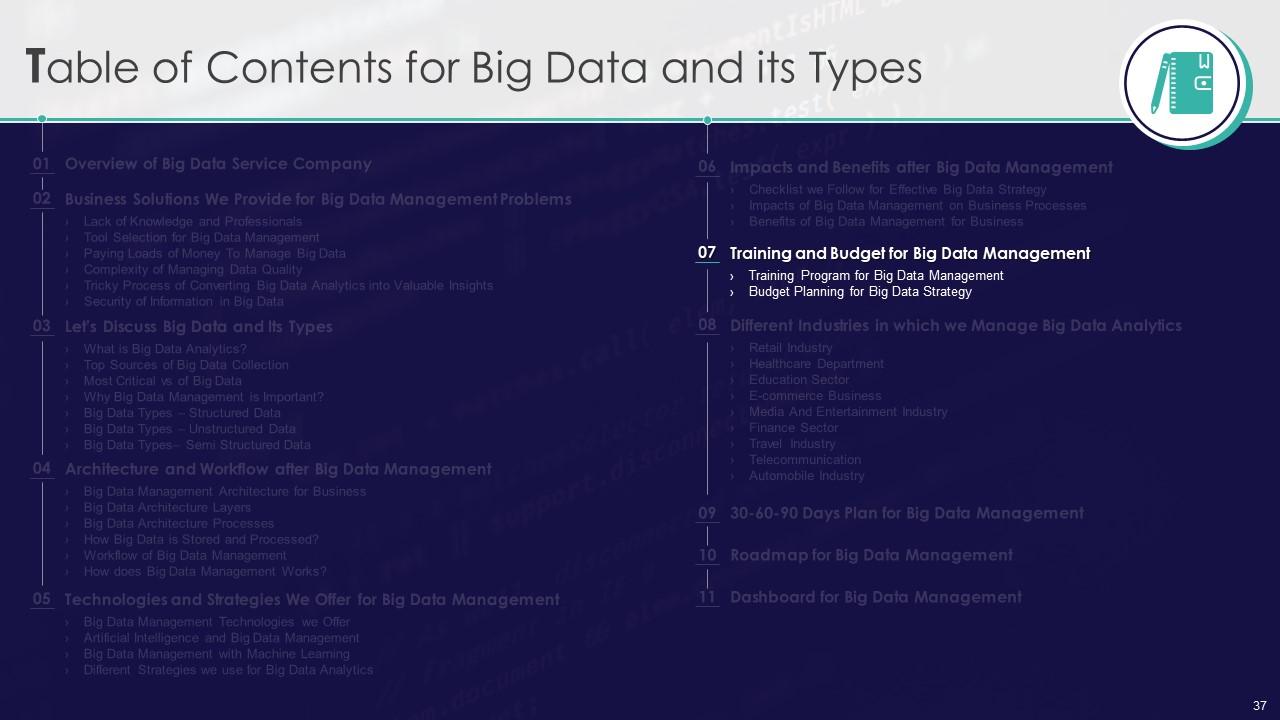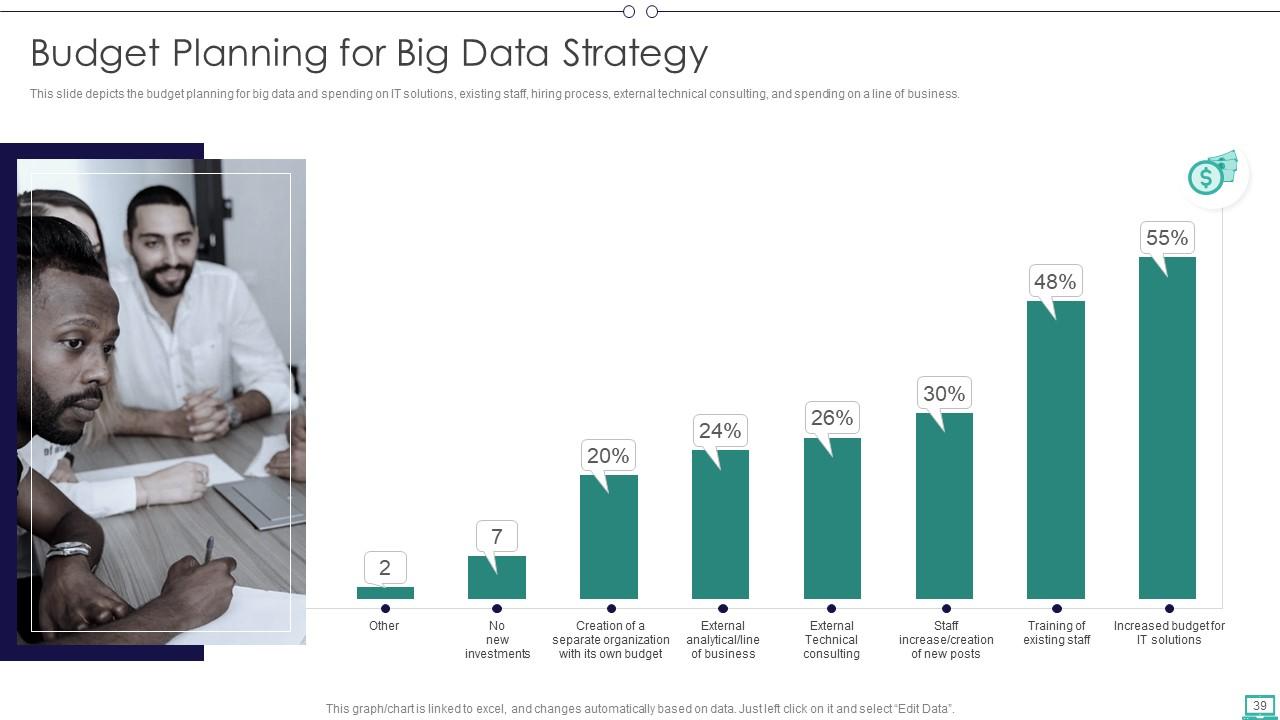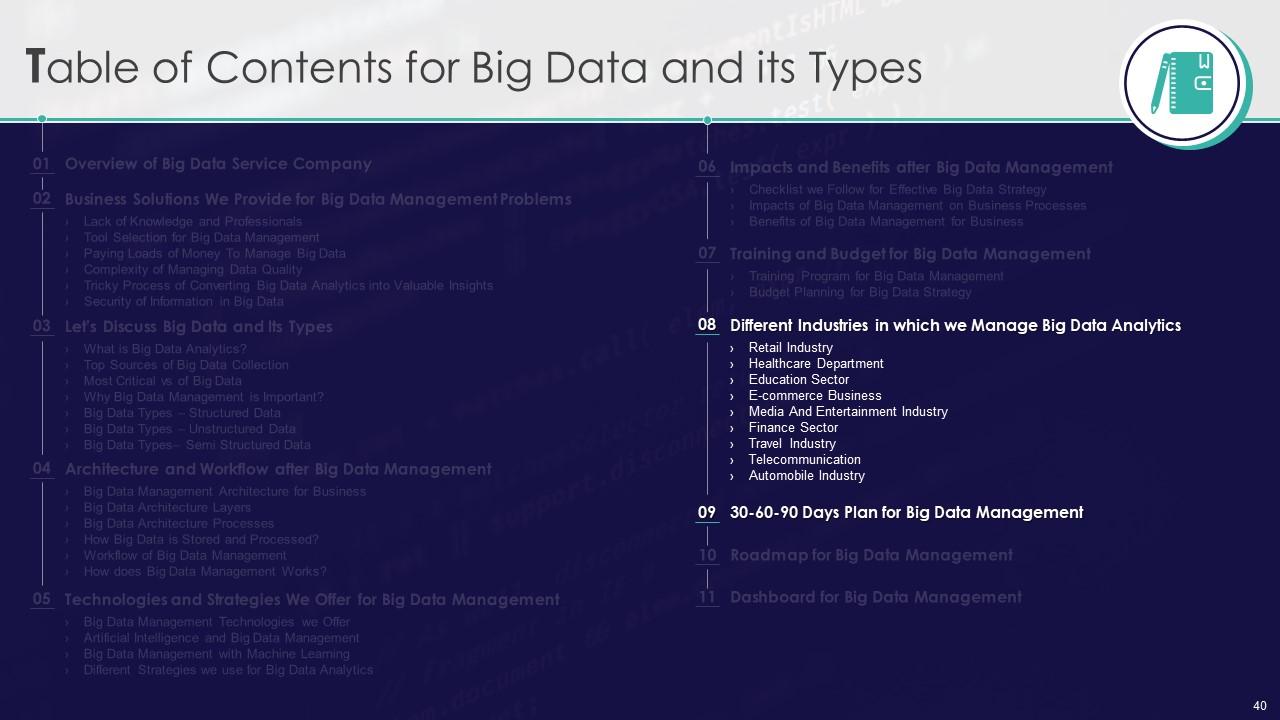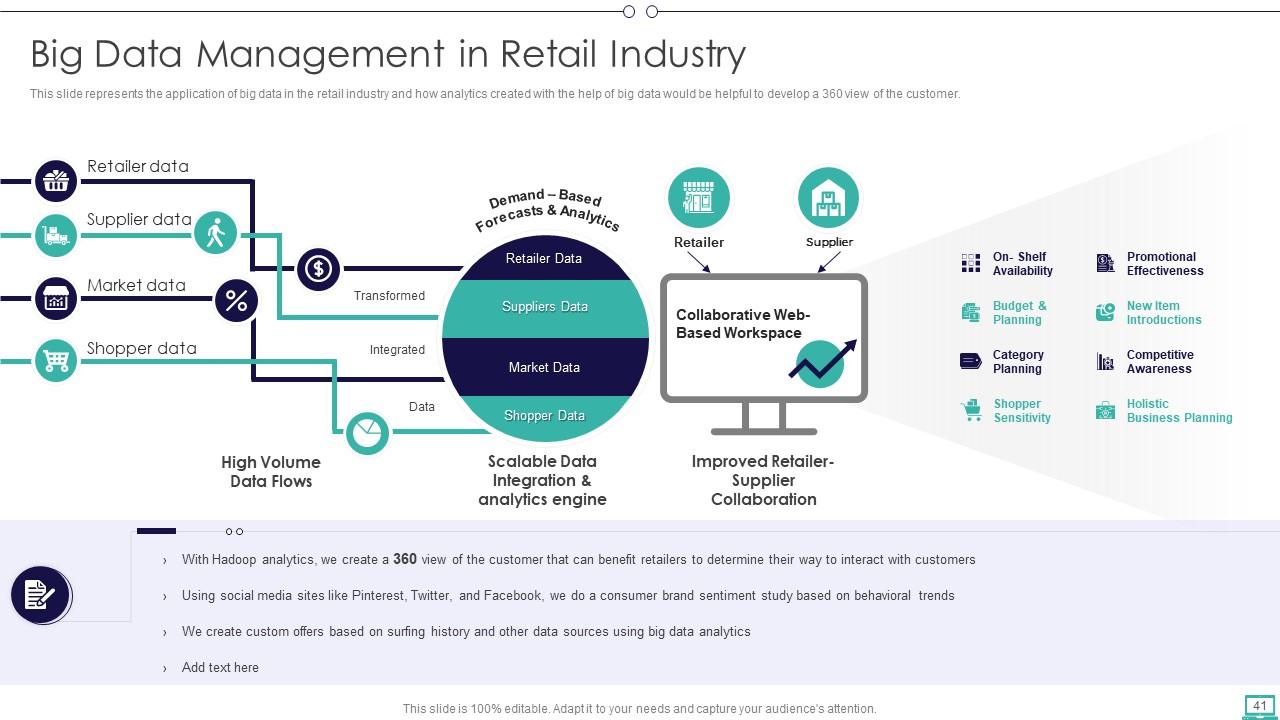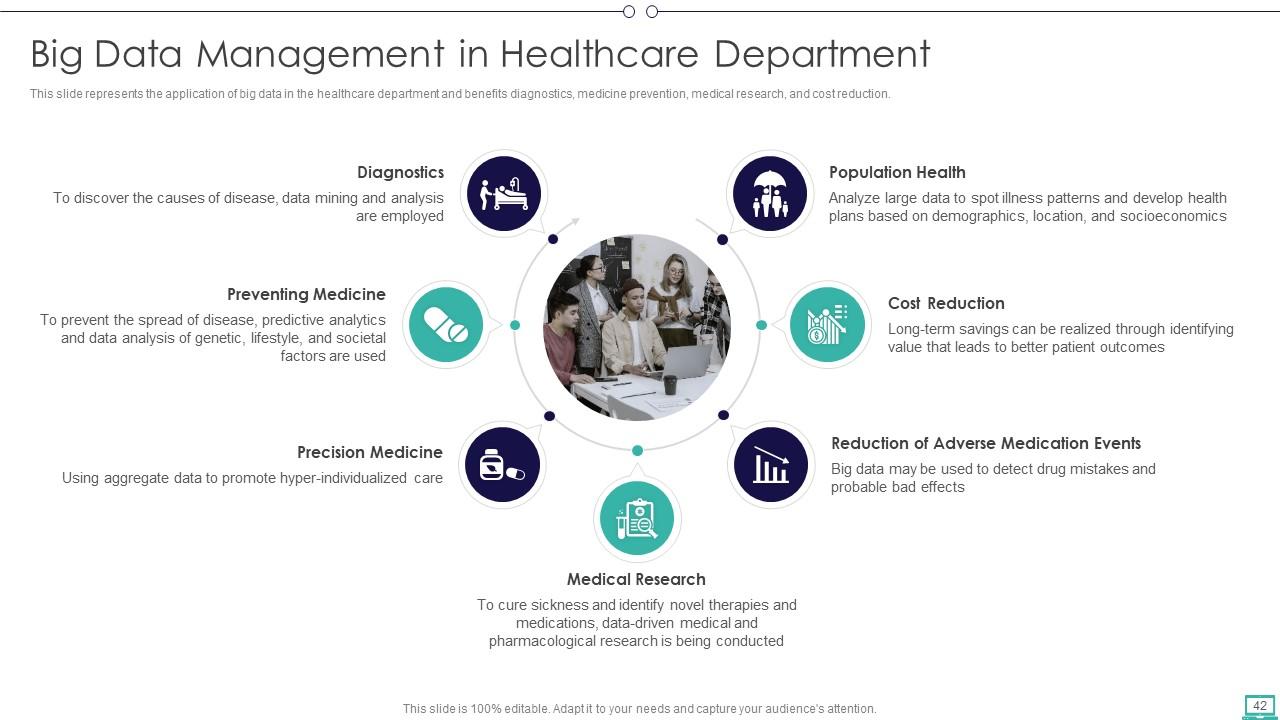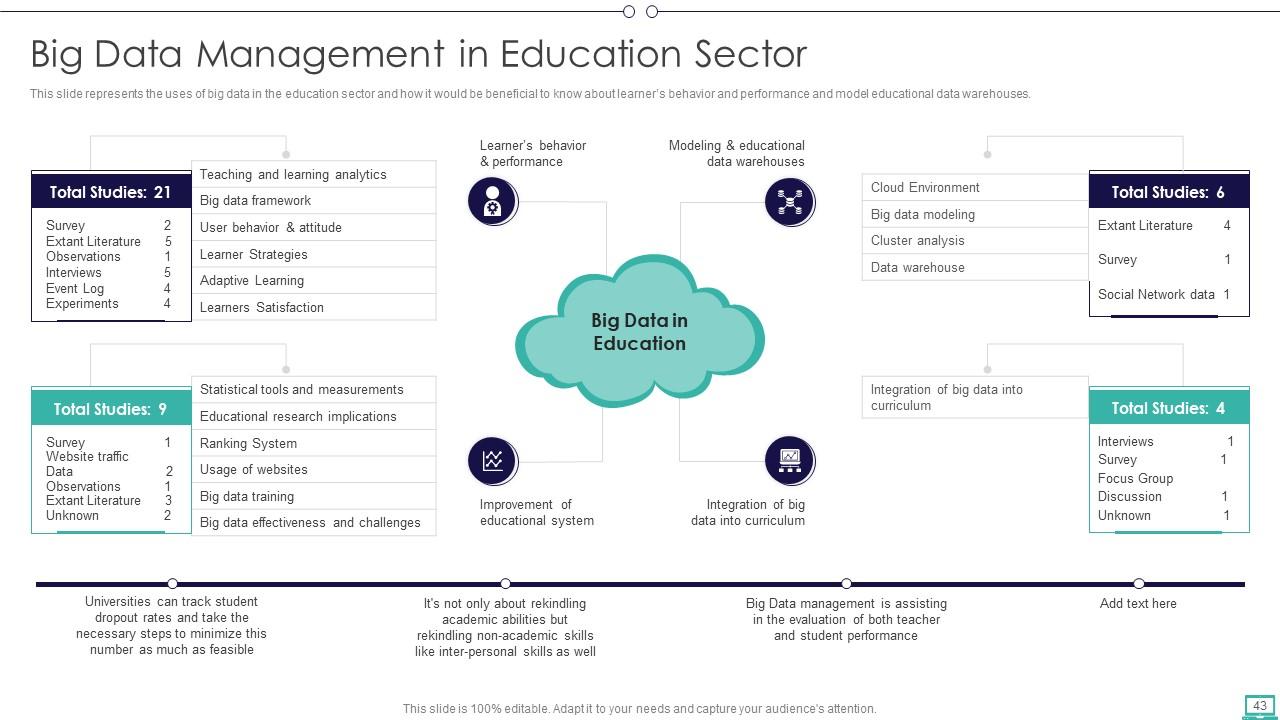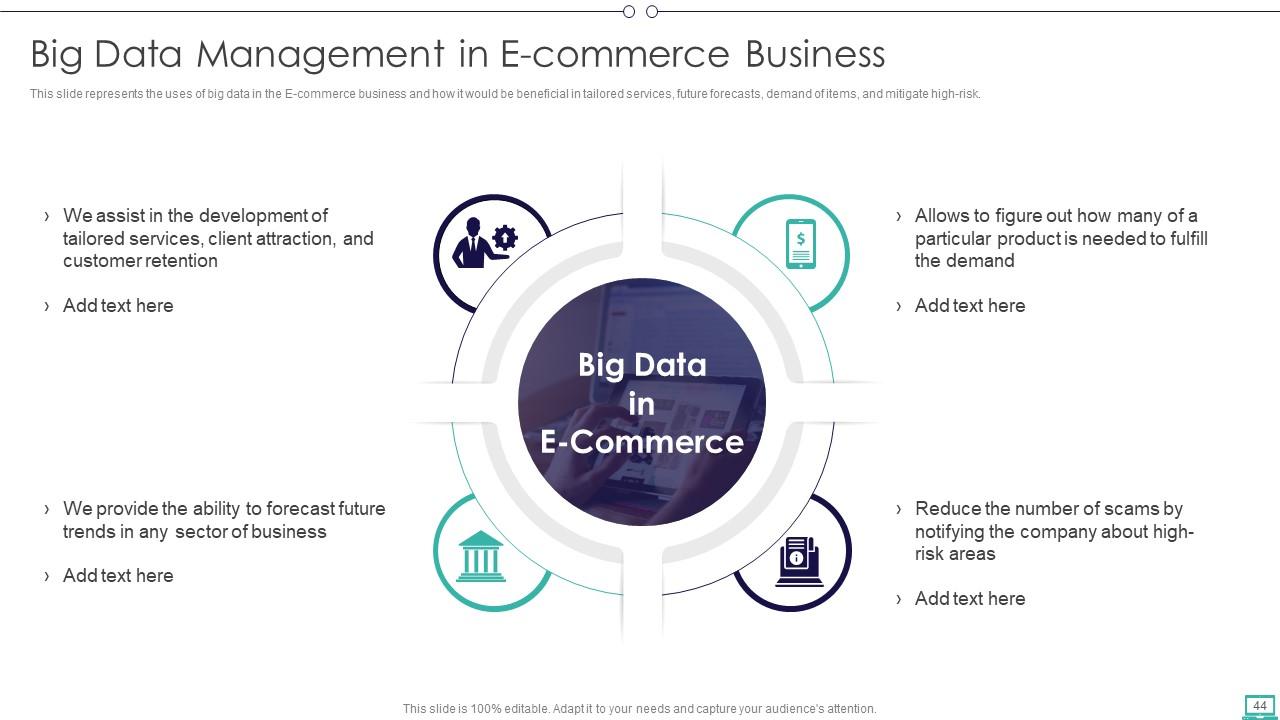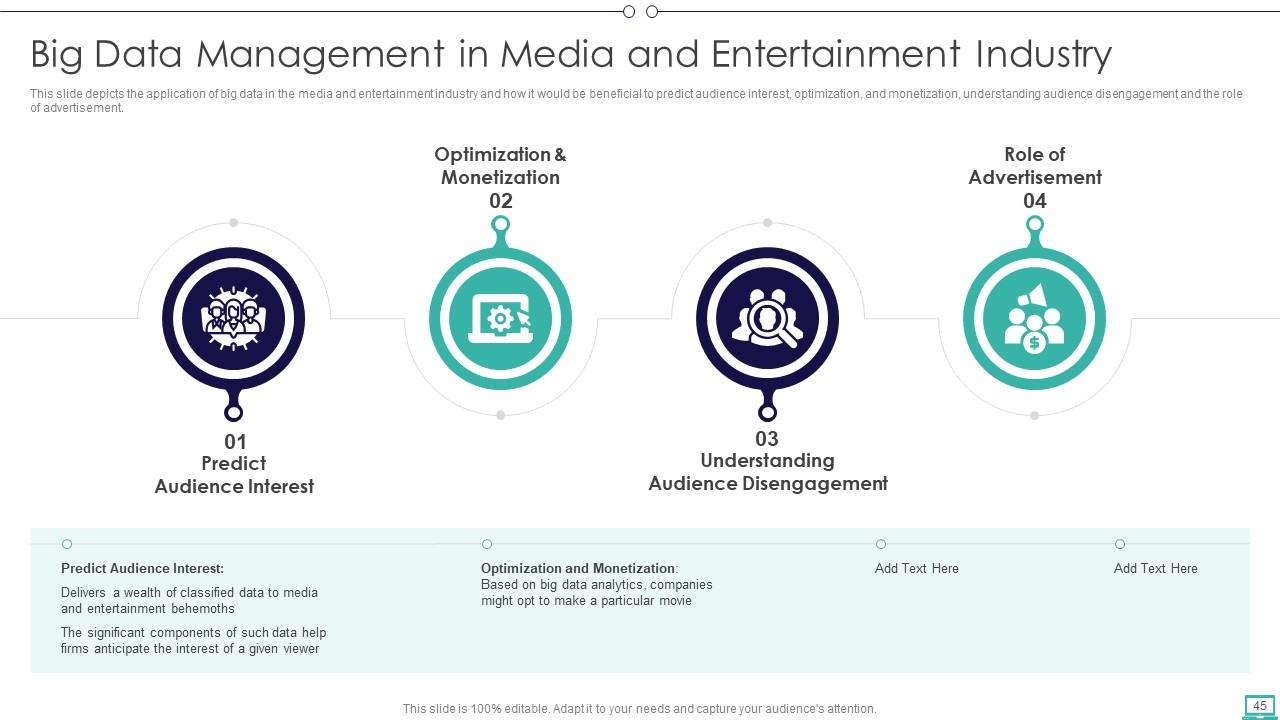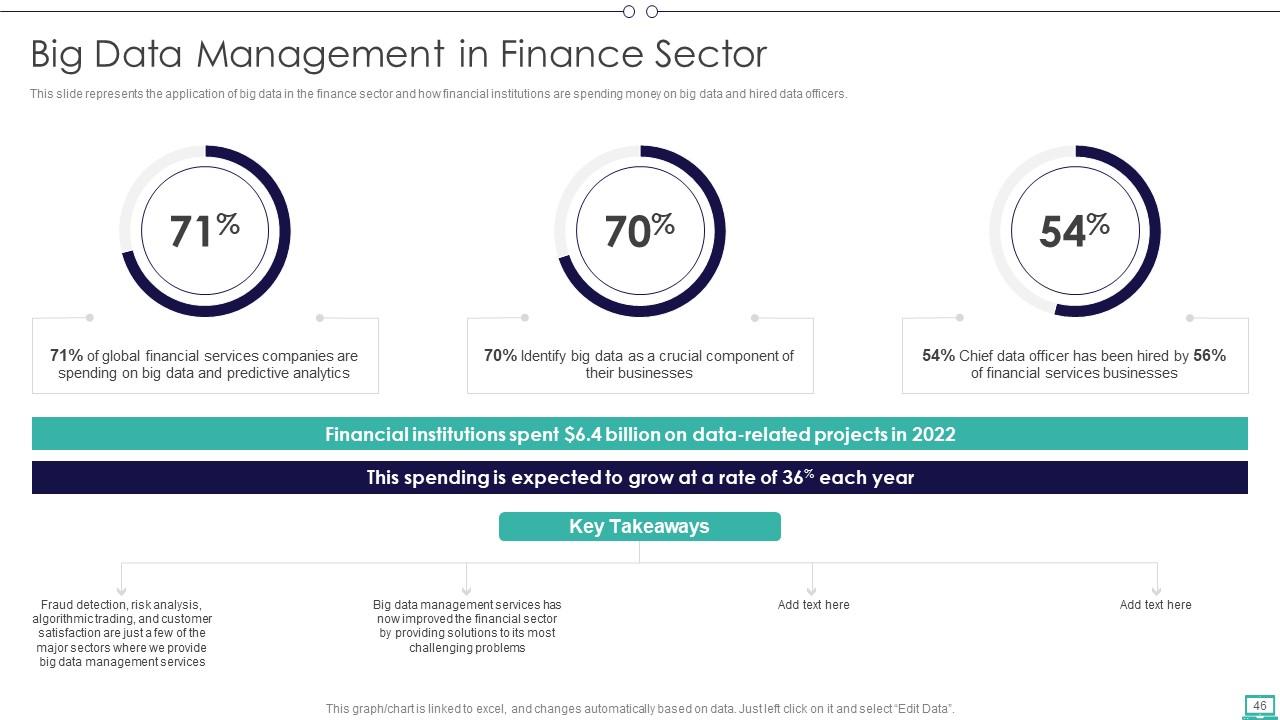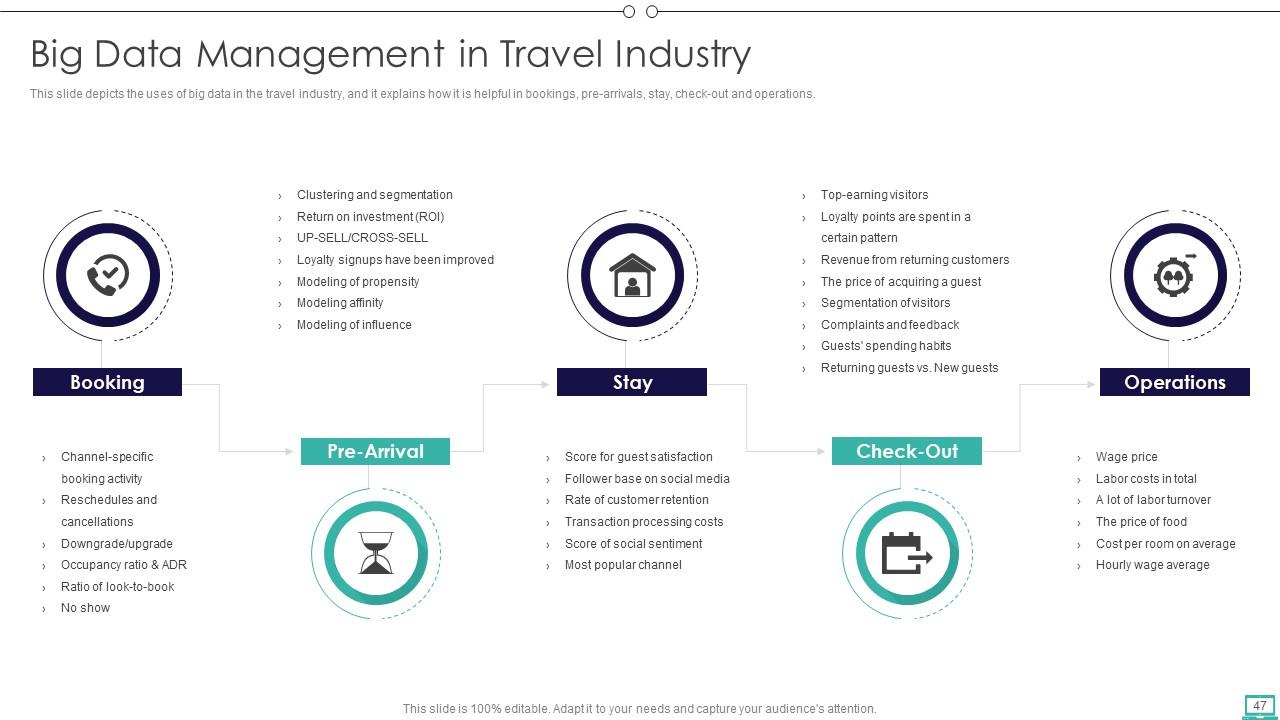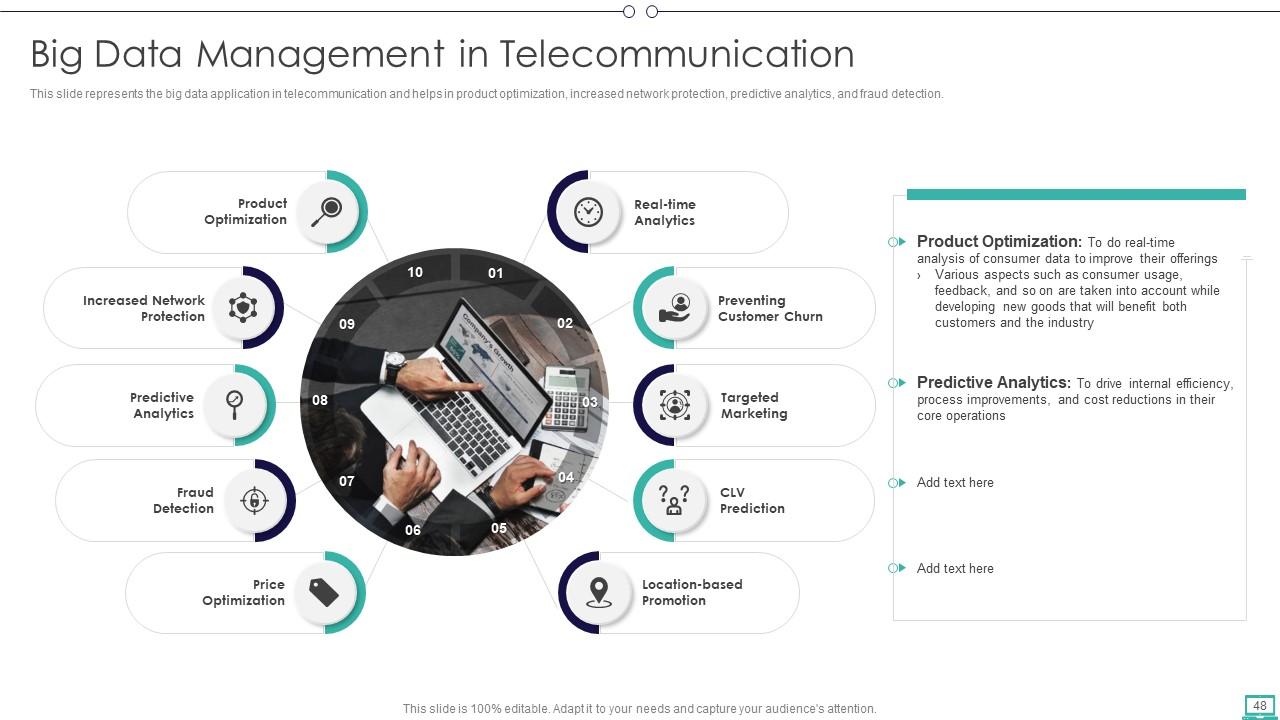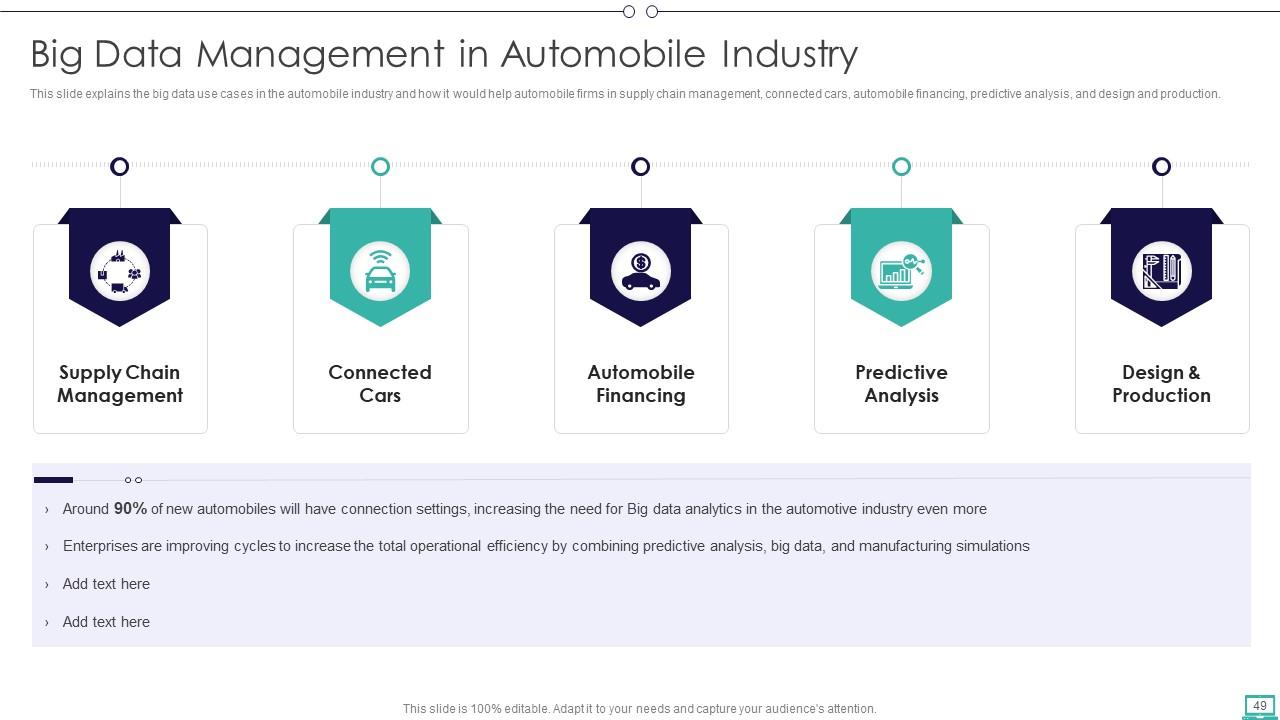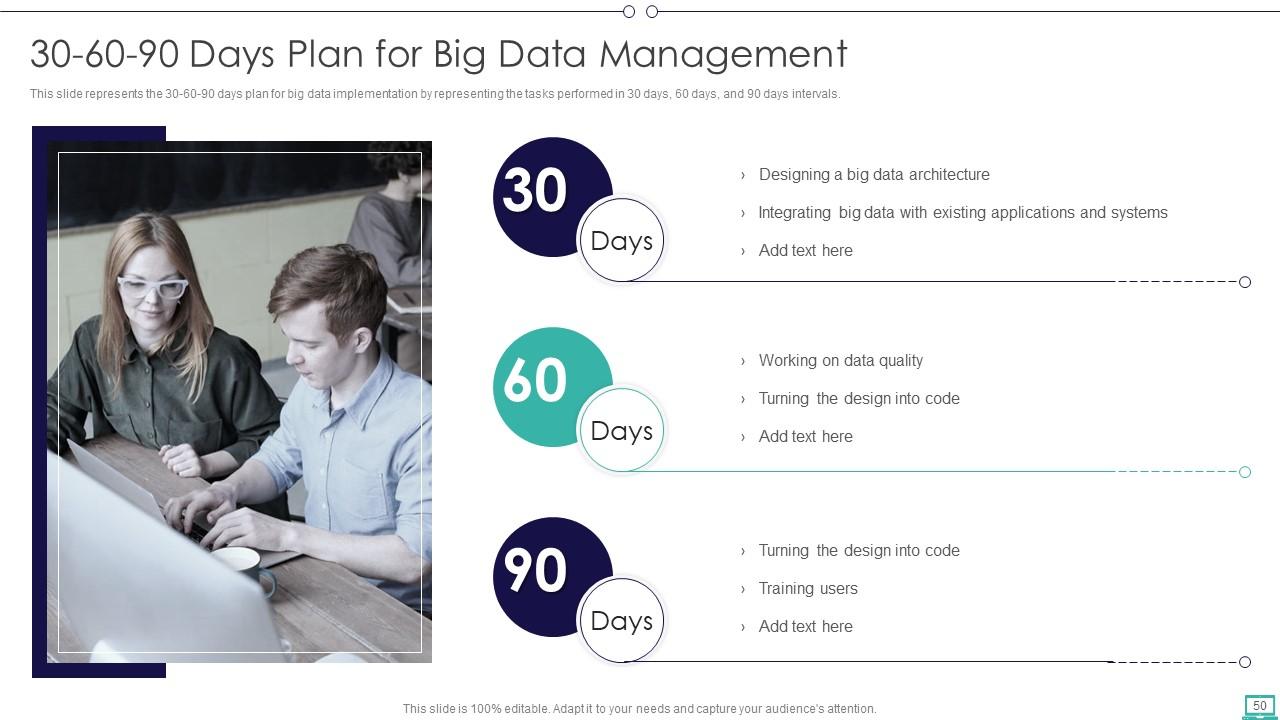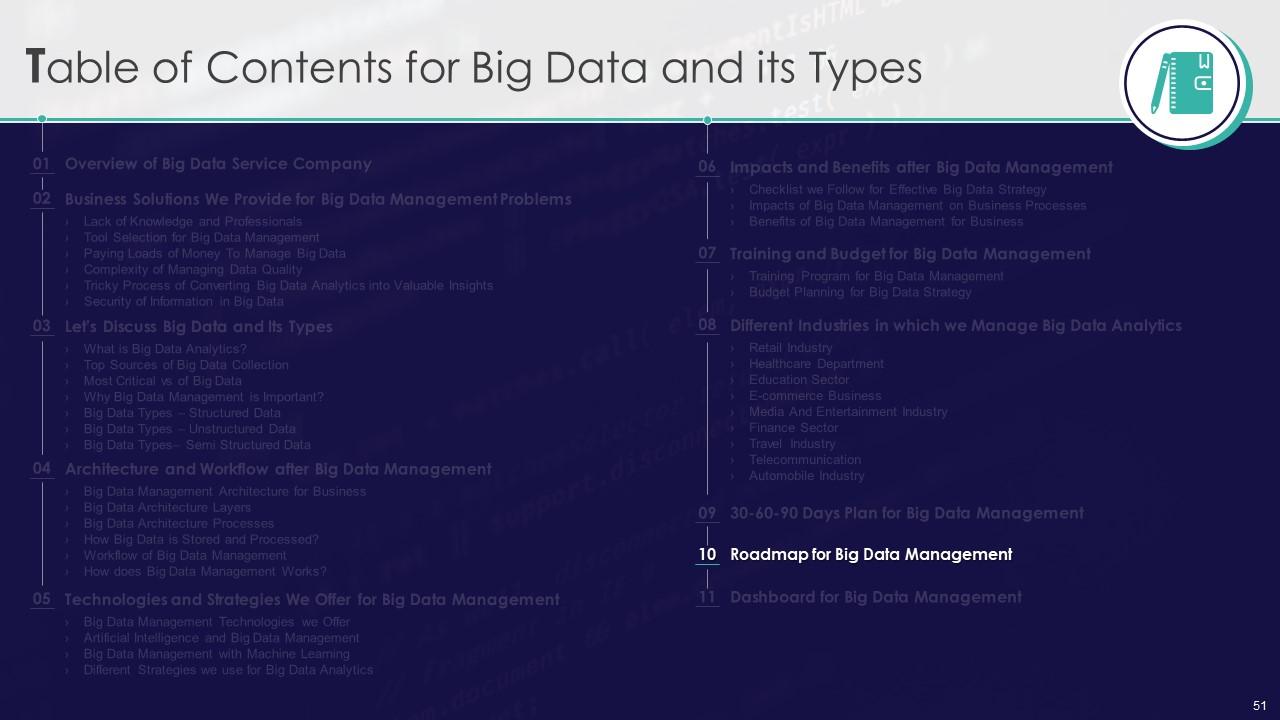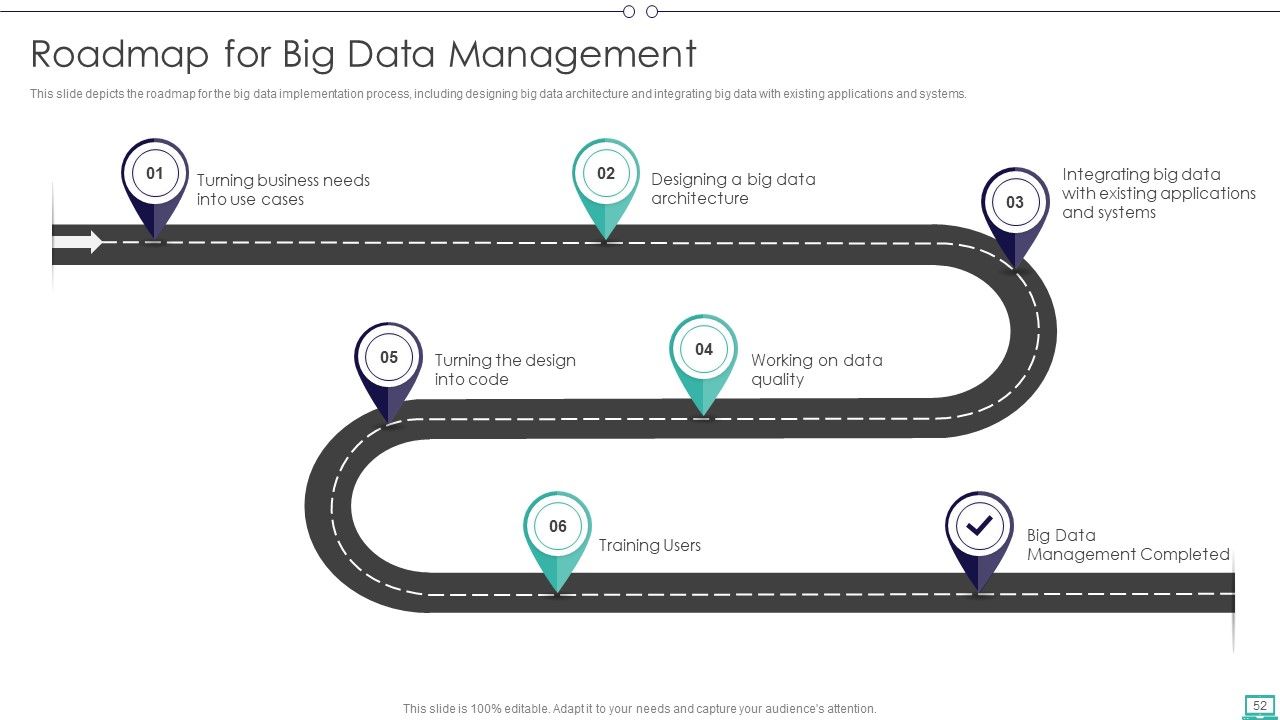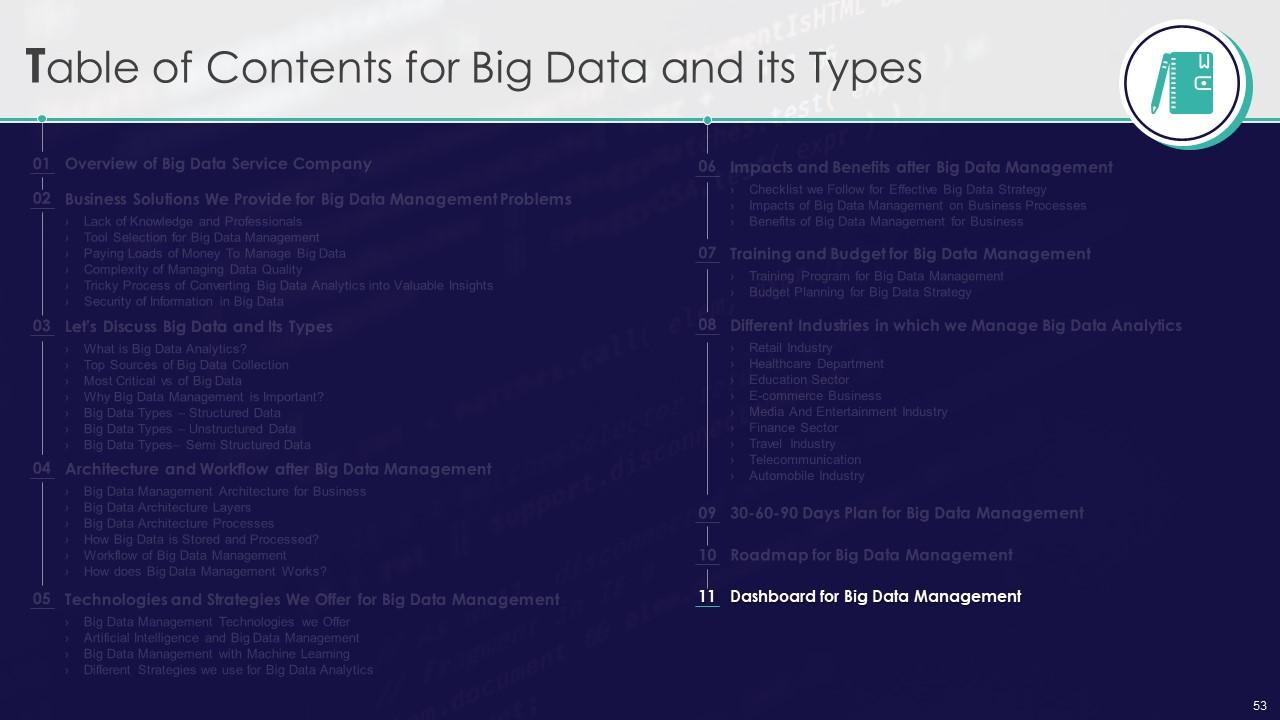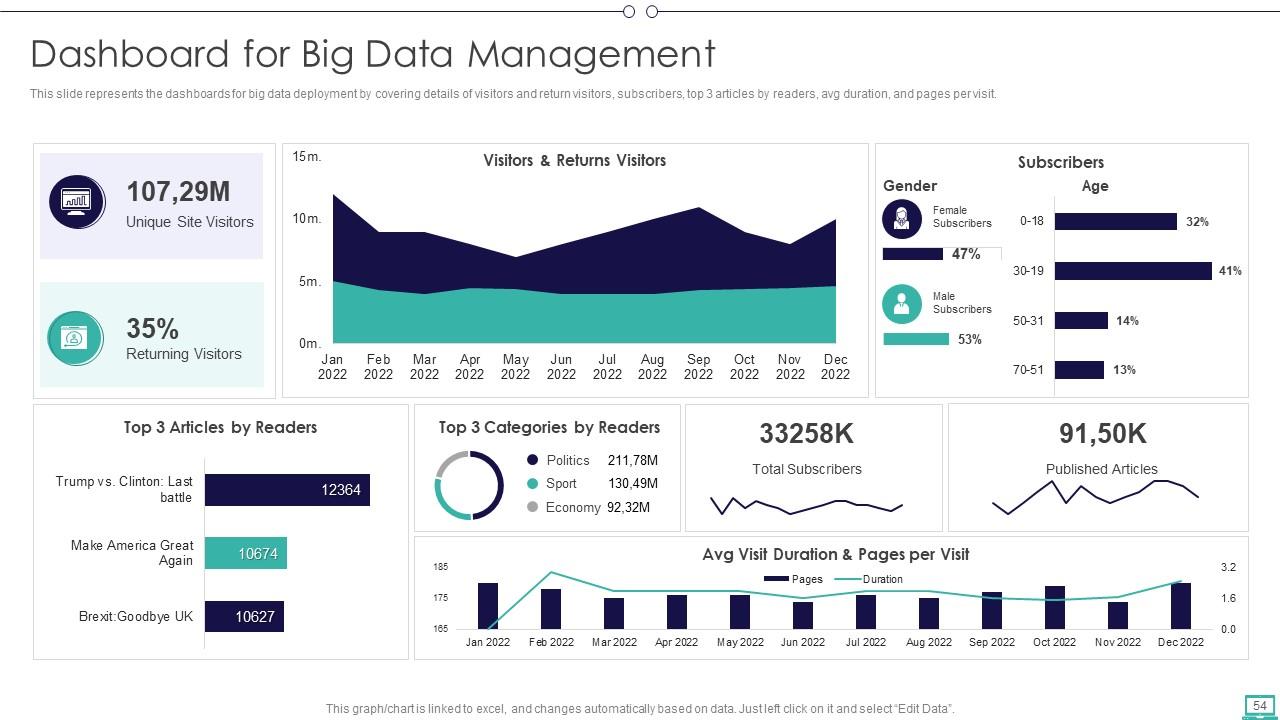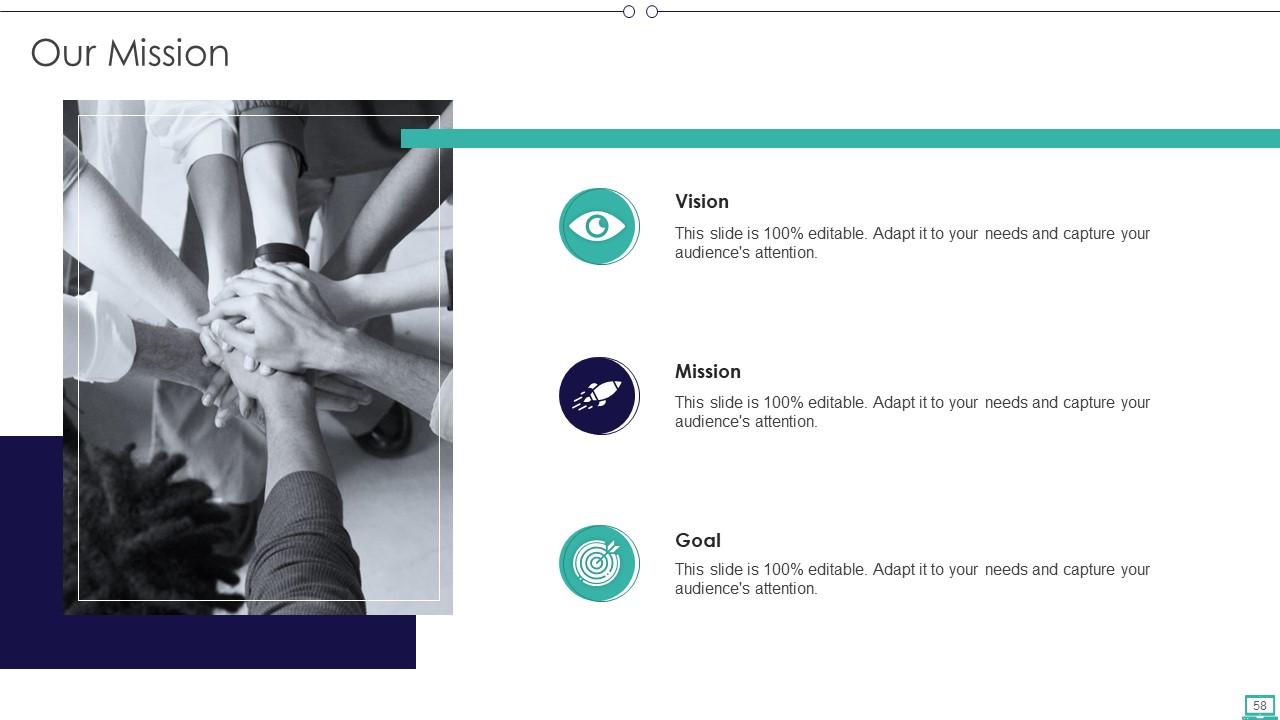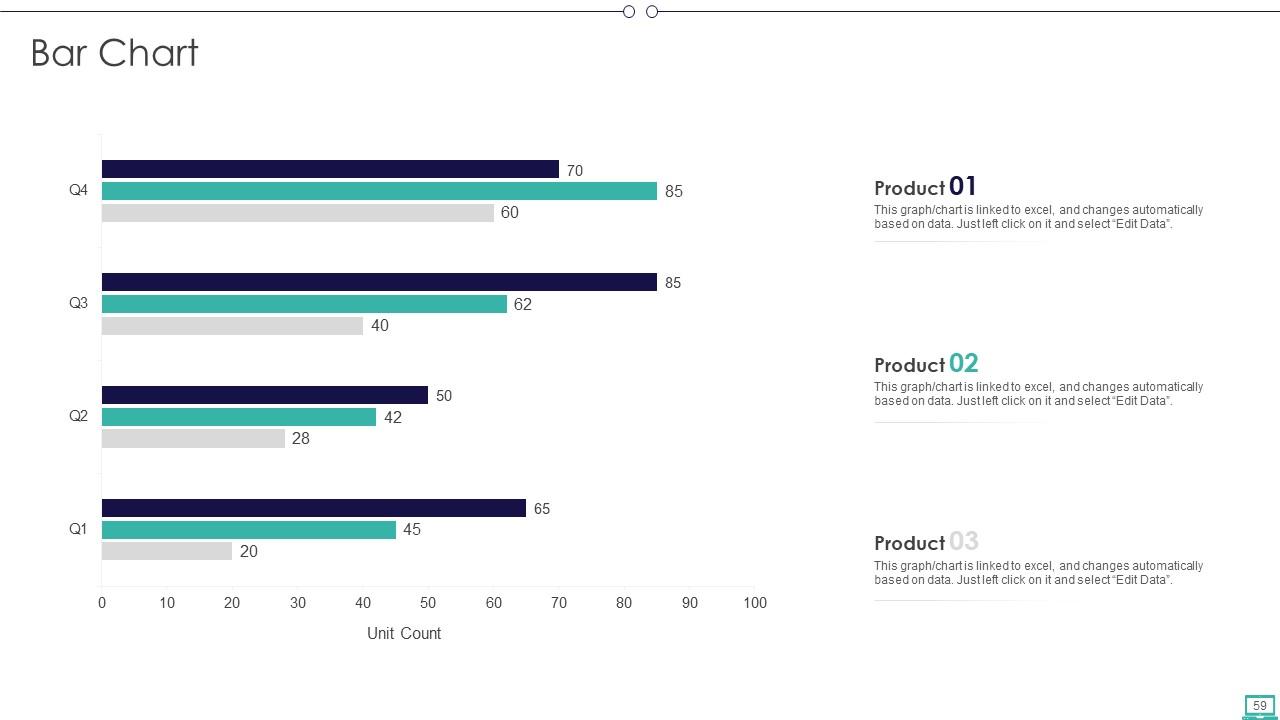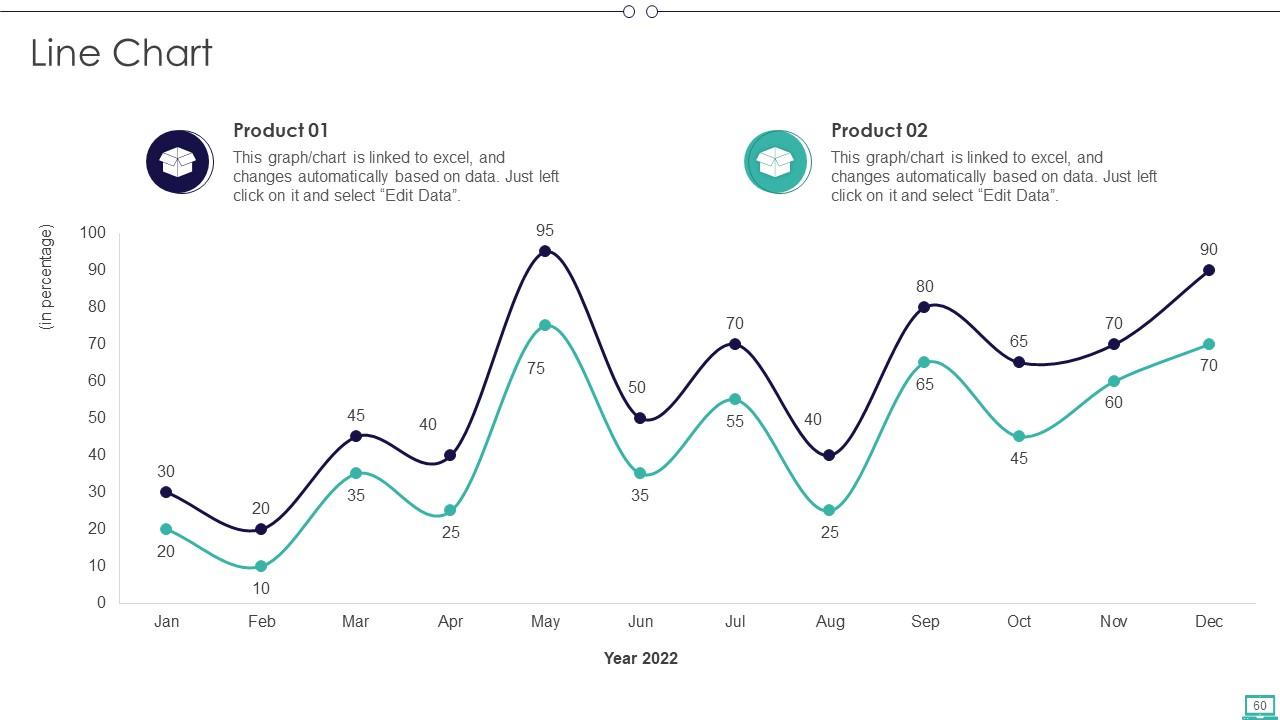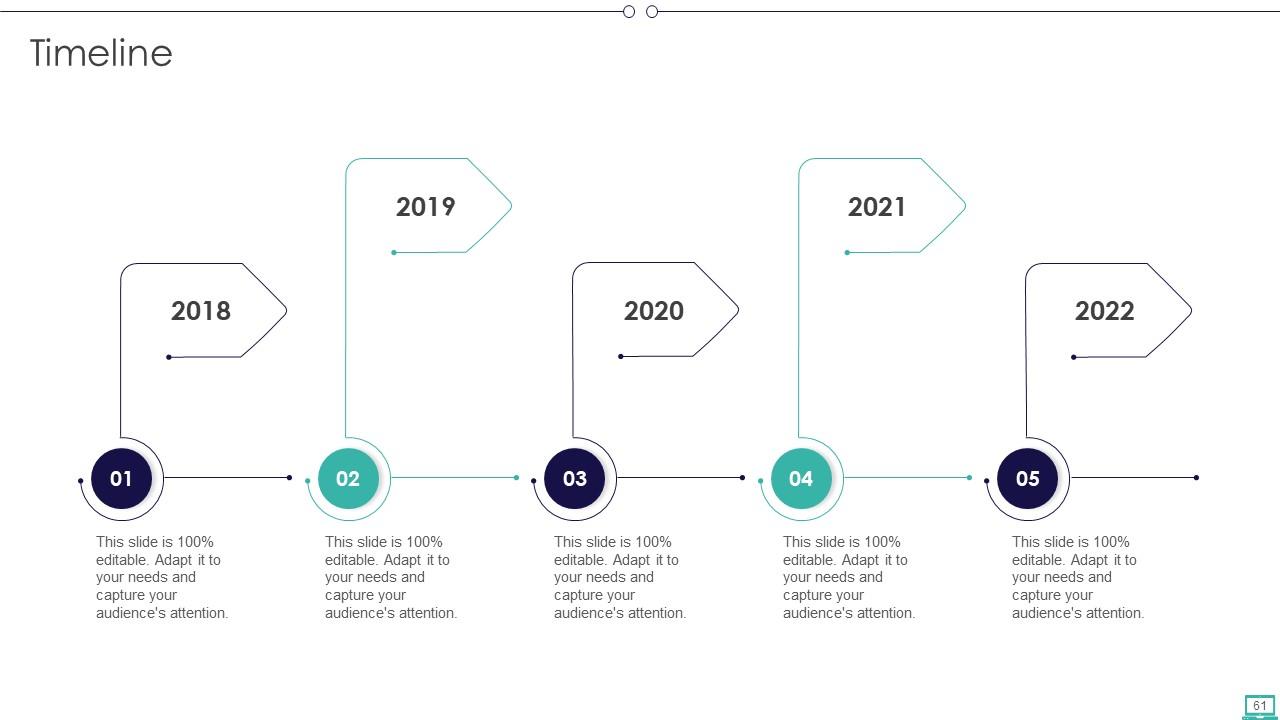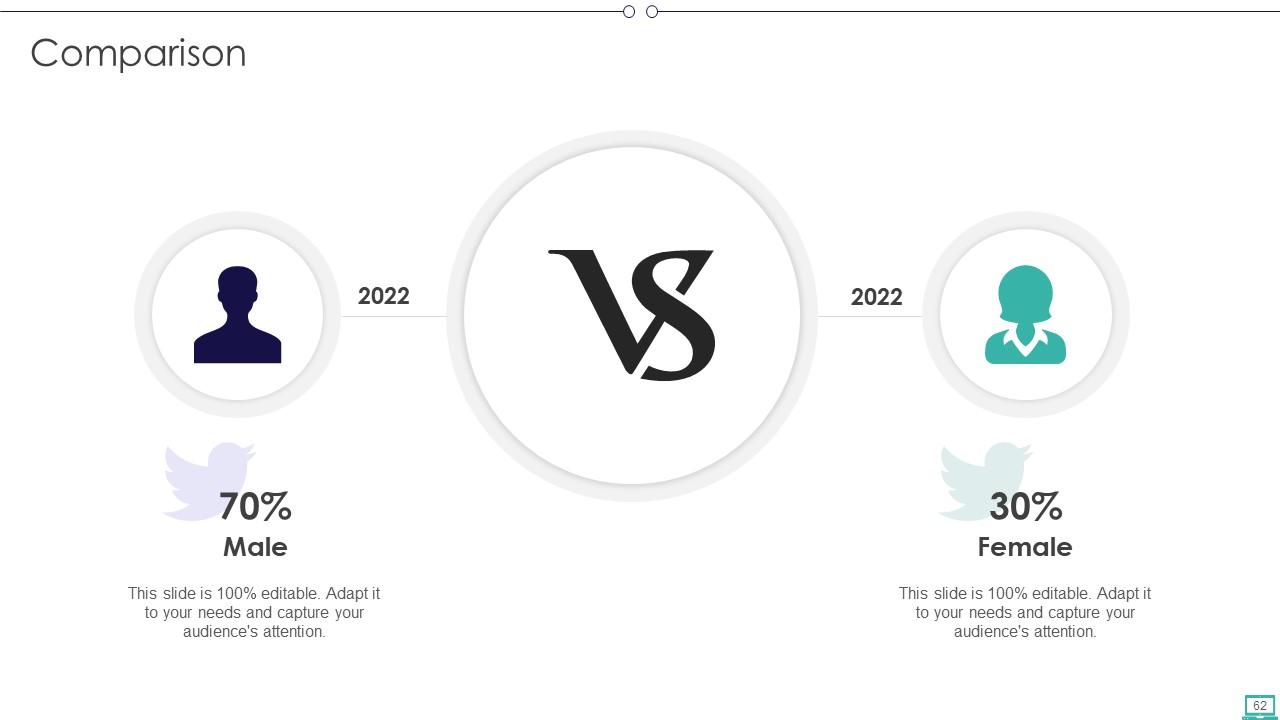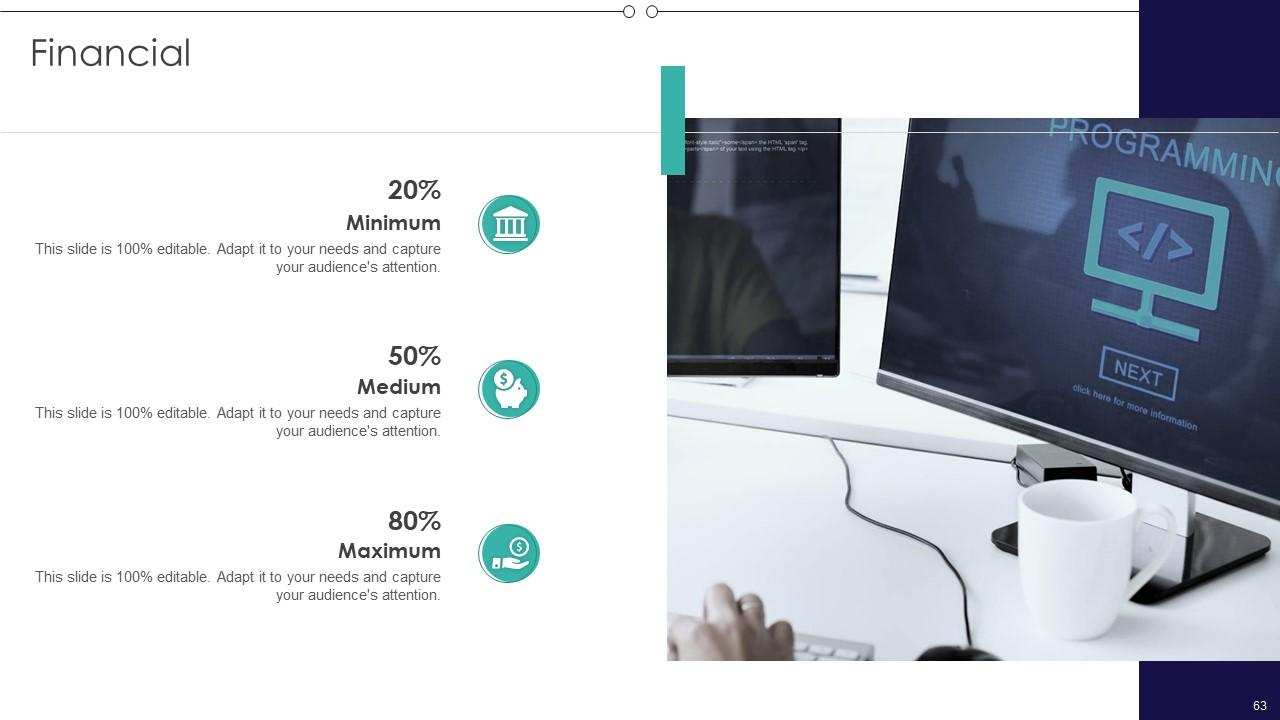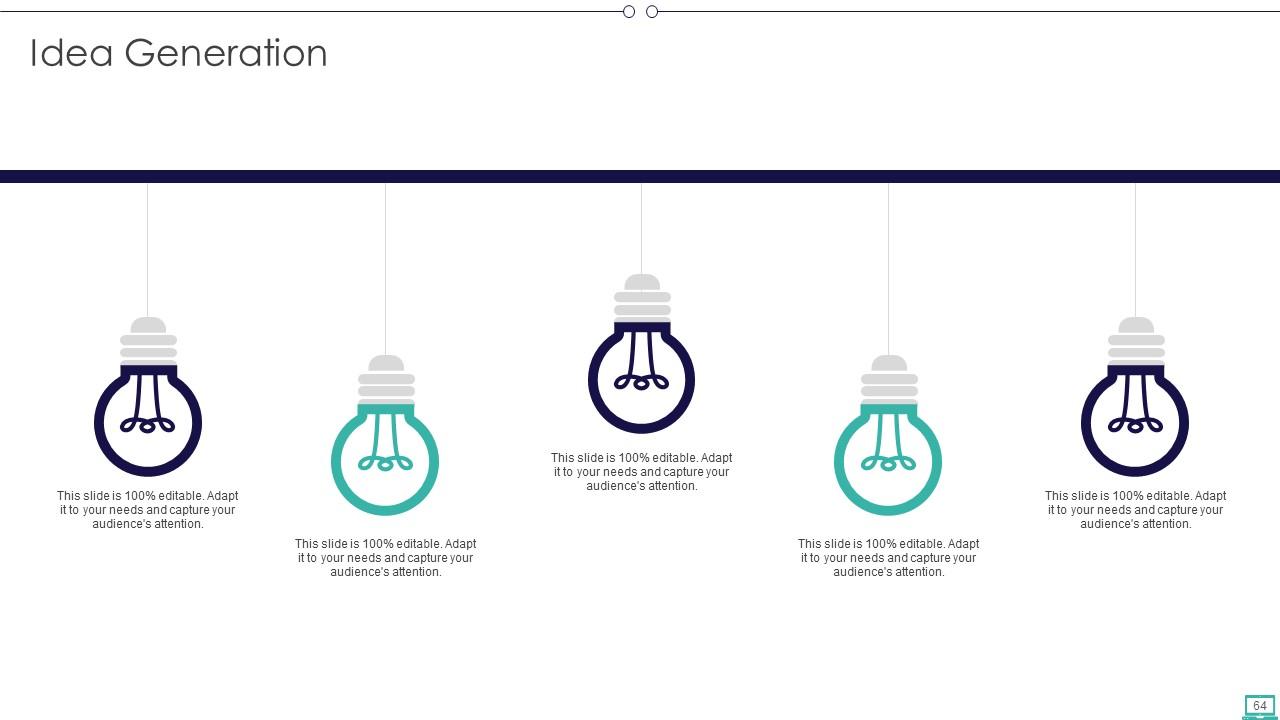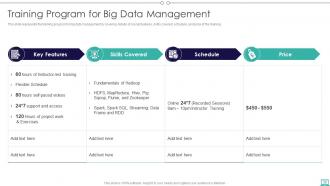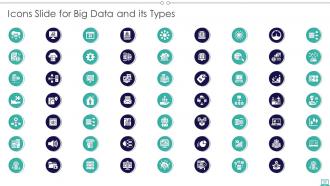Big Data And Its Types Powerpoint Presentation Slides
Big Data is a massive collection of data that continues to increase dramatically over time. It is a data set that is so vast and complicated that no standard data management technologies can effectively hold or handle it. Grab our efficiently designed Big Data and its Types template that provides details about the problems experienced by organizations to manage big data and their solutions. It further highlights the top sources of big data analytics, architecture, and workflow of extensive data management. This presentation covers sections for the different types of data, multiple resources of big data analytics, working of big data analytics, technologies, etc. It also comes with a ready-made checklist for big data analytics management. Additionally, this PPT talks about the impacts of extensive data management on business processes and their benefits. Furthermore, this template includes a training program for comprehensive data management, budget planning, and big data analytics applications in different sectors such as healthcare, education, automobile, finance, etc. Lastly, this deck comprises a dashboard for comprehensive data management. Download it now.
Big Data is a massive collection of data that continues to increase dramatically over time. It is a data set that is so vas..
- Google Slides is a new FREE Presentation software from Google.
- All our content is 100% compatible with Google Slides.
- Just download our designs, and upload them to Google Slides and they will work automatically.
- Amaze your audience with SlideTeam and Google Slides.
-
Want Changes to This PPT Slide? Check out our Presentation Design Services
- WideScreen Aspect ratio is becoming a very popular format. When you download this product, the downloaded ZIP will contain this product in both standard and widescreen format.
-

- Some older products that we have may only be in standard format, but they can easily be converted to widescreen.
- To do this, please open the SlideTeam product in Powerpoint, and go to
- Design ( On the top bar) -> Page Setup -> and select "On-screen Show (16:9)” in the drop down for "Slides Sized for".
- The slide or theme will change to widescreen, and all graphics will adjust automatically. You can similarly convert our content to any other desired screen aspect ratio.
Compatible With Google Slides

Get This In WideScreen
You must be logged in to download this presentation.
PowerPoint presentation slides
This complete presentation has PPT slides on wide range of topics highlighting the core areas of your business needs. It has professionally designed templates with relevant visuals and subject driven content. This presentation deck has total of sixty five slides. Get access to the customizable templates. Our designers have created editable templates for your convenience. You can edit the color, text and font size as per your need. You can add or delete the content if required. You are just a click to away to have this ready-made presentation. Click the download button now.
People who downloaded this PowerPoint presentation also viewed the following :
Content of this Powerpoint Presentation
Slide 1: This slide displays title i.e. 'Big Data and its Types' and your Company Name.
Slide 2: This slide presents agenda.
Slide 3: This slide exhibits table of contents.
Slide 4: This slide depicts title for one topic that is to be covered next in the template.
Slide 5: This slide represents the overview of the big data company by covering details of their total associates, entire countries they served in, and total income.
Slide 6: This slide depicts title for six topics that are to be covered next in the template.
Slide 7: This slide represents one challenge of big data that is lack of knowledge and professionals and solution to this challenge.
Slide 8: This slide defines the big data tool selection challenge that organizations face.
Slide 9: This slide explains another challenge that is paying loads of money on hardware, new hires, software development, and its solution.
Slide 10: This slide depicts another big data challenge that is the complexity of managing data quality due to different data formats and sources of information.
Slide 11: This slide represents another challenge of big data that is the tricky process of converting big data into valuable insights.
Slide 12: This slide represents the securing information in big data challenge of big data and solutions to this challenge.
Slide 13: This slide depicts title for seven topics that are to be covered next in the template.
Slide 14: This slide represents the meaning of big data and the complete data handling process such as data collection, storage, research, etc.
Slide 15: This slide describes the top sources of big data collection such as media data, cloud data, web data, machine data, etc.
Slide 16: This slide represents the most critical Vs of big data such as volume, variety, velocity, veracity, value, and variability and how they work.
Slide 17: This slide depicts the importance of big data and how collected data will help organizations in cost-saving, time savings, etc.
Slide 18: This slide represents the structured data type of big data and how data is kept in specific formats that are handled by machines only.
Slide 19: This slide depicts the unstructured data form of big data and how it can be any form such as videos, audio, likes, and comments.
Slide 20: This slide represents the semi-structured data form of big data, and it contains both of the data forms, such as structured and unstructured data.
Slide 21: This slide depicts title for six topics that are to be covered next in the template.
Slide 22: This slide explains the architecture of big data and its various components such as data sources, data storage, etc.
Slide 23: This slide describes the layers of big data architecture that include the big data source layer, management & storage layer, etc.
Slide 24: This slide depicts the processes of big data architecture.
Slide 25: This slide represents how big data is stored and processed.
Slide 26: This slide defines the workflow of big data, including data sources, data management, modeling, result analysis, visualization, and user interaction.
Slide 27: This slide depicts how big data works, and its working falls in three stages: gathering data, storing data, and analyzing big data.
Slide 28: This slide depicts title for four topics that are to be covered next in the template.
Slide 29: This slide represents the leading big data management technologies, and it includes the Hadoop ecosystem, AI, etc.
Slide 30: This slide explains the relationship between artificial intelligence and big data and how it would help detect anomalies, etc.
Slide 31: This slide depicts a comparison between big data and machine learning based on its working, algorithms, data sources, and way of data analysis.
Slide 32: This slide represents different big data analytics branches, including comparative analysis, social media listening, etc.
Slide 33: This slide depicts title for three topics that are to be covered next in the template.
Slide 34: This slide explains the checklist for big data.
Slide 35: This slide represents the impacts of the big data deployment on the organization.
Slide 36: This slide represents the benefits of big data for business, and it includes reduced costs, increased revenue, etc.
Slide 37: This slide depicts title for two topics that are to be covered next in the template.
Slide 38: This slide represents the training program for big data management by covering details of crucial features, skills covered, schedule, etc.
Slide 39: This slide depicts the budget planning for big data and spending on IT solutions, existing staff, hiring process, etc.
Slide 40: This slide depicts title for ten topics that are to be covered next in the template.
Slide 41: This slide represents the application of big data in the retail industry.
Slide 42: This slide represents the application of big data in the healthcare department and benefits diagnostics, medicine prevention, etc.
Slide 43: This slide represents the uses of big data in the education sector.
Slide 44: This slide represents the uses of big data in the E-commerce business and how it would be beneficial in tailored services, future forecasts, etc.
Slide 45: This slide depicts the application of big data in the media and entertainment industry.
Slide 46: This slide represents the application of big data in the finance sector and how financial institutions are spending money on big data and hired data officers.
Slide 47: This slide depicts the uses of big data in the travel industry, and it explains how it is helpful in bookings, pre-arrivals, stay, check-out and operations.
Slide 48: This slide represents the big data application in telecommunication and helps in product optimization, increased network protection, etc.
Slide 49: This slide explains the big data use cases in the automobile industry and how it would help automobile firms in supply chain management, etc.
Slide 50: This slide represents the 30-60-90 days plan for big data implementation by representing the tasks performed in 30 days, 60 days, and 90 days intervals.
Slide 51: This slide depicts title for one topic that is to be covered next in the template.
Slide 52: This slide depicts the roadmap for the big data implementation process, including designing big data architecture and integrating big data.
Slide 53: This slide depicts title for one topic that is to be covered next in the template.
Slide 54: This slide represents the dashboards for big data deployment by covering details of visitors and return visitors, subscribers, etc.
Slide 55: This is the icons slide.
Slide 56: This slide presents title for additional slides.
Slide 57: This slide shows about your company, target audience and its client's values.
Slide 58: This slide presents your company's vision, mission and goals.
Slide 59: This slide exhibits quarterly bar charts for different products. The charts are linked to Excel.
Slide 60: This slide exhibits monthly line charts for different products. The charts are linked to Excel.
Slide 61: This slide exhibits yearly timeline.
Slide 62: This slide highlights comparison of products based on selects.
Slide 63: This slide showcases financials.
Slide 64: This slide exhibits ideas generated.
Slide 65: This is thank you slide & contains contact details of company like office address, phone no., etc.
Big Data And Its Types Powerpoint Presentation Slides with all 70 slides:
Use our Big Data And Its Types Powerpoint Presentation Slides to effectively help you save your valuable time. They are readymade to fit into any presentation structure.
FAQs
Big data can bring various benefits to businesses, such as identifying new revenue opportunities, reducing costs, improving decision-making, enhancing customer experience, optimizing marketing strategies, and increasing operational efficiency.
Traditional data analytics deals with smaller datasets that are structured and pre-defined, while big data analytics deals with large volumes of structured, semi-structured, and unstructured data from various sources. Big data analytics requires advanced tools and techniques, such as Hadoop, NoSQL databases, and machine learning algorithms, to handle and analyze the data.
The architecture of big data includes various components such as data sources, data storage, data processing, and data presentation. It also includes layers, such as the big data source layer, management & storage layer, and processing & analysis layer.
There are three main types of data in big data: structured, unstructured, and semi-structured. Structured data is kept in specific formats that are handled by machines only. Unstructured data can be any form such as videos, audio, likes, and comments. Semi-structured data contains both structured and unstructured data.
Some of the common challenges organizations face in implementing big data solutions include lack of skilled professionals, high costs of hardware and software, managing data quality, dealing with a large volume of data, and ensuring data security and privacy.
-
Designs have enough space to add content.
-
I joined SlideTeam last month and there’s no doubt that I tend to find our bond only strengthening over time. Best place to find world-class themes, templates, and icons.


